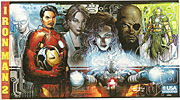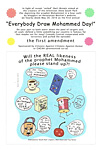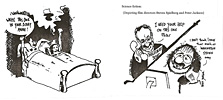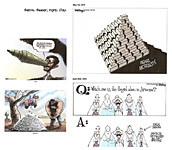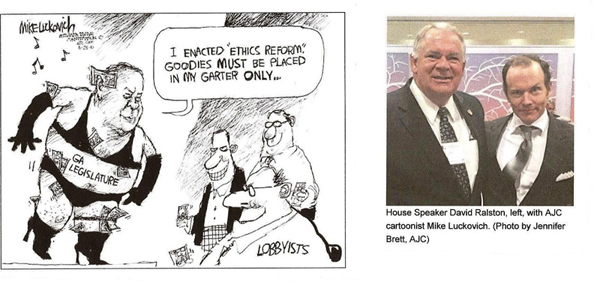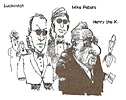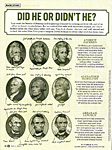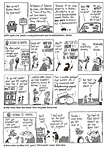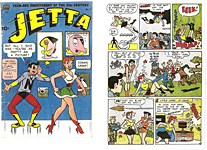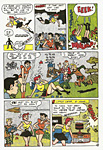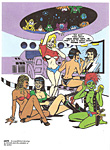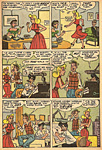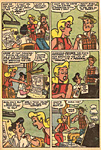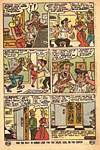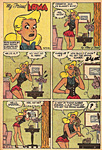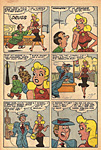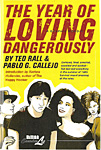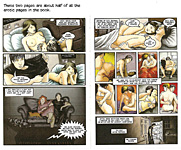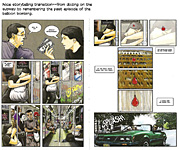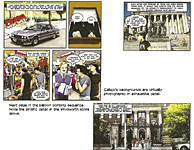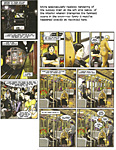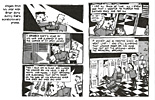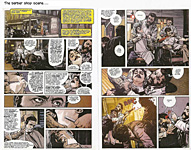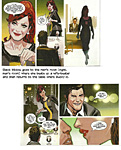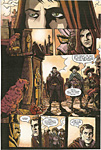 |
||||||||||||||||||||
Opus 261 (May 6, 2010). We seem to have degenerated into a monthly magazine, but the quantity, we trust, will make up for being less frequent. Hopping down the bunny trail this time, we celebrate the Schulz heirs getting a hunk of the licensing rights to Peanuts, view with alarm the phoney excitement over cartooning Muhammad on “South Park,” rejoice (at great length) in Archie Comics’ increased aggressiveness in the marketplace of modernity (and their persistent promotion of their product with newsstories about Archie’s new married series and the arrival in Riverdale of a gay classmate), and perform an exhaustive review of Ted Rall’s Year of Loving Dangerously graphic memoir. We also review first issues of Turf, Black Widow, and Kill Shakespeare, herald Hef’s saving of Hollywood, and examine the history of Palestine and our news media’s failure to be objective about it. Here’s what’s here, in order, by department: NOUS R US Penny Arcade in Time’s 100 Influential Schulz Heirs Get Rights to Charlie and the Gang Muhammad in South Park “Everybody Draw Muhammad Day” Debuts but Fizzles The Other Muslim Cartoon Controversy More Editorial Cartoon Awards Frazetta Flap Folds Hef Saves Hollywood ARCHIE COMICS GETS AGGRESSIVE Archie Still Married to Betty and Veronica Gay Guy Moves in to Riverdale amid Much Fussin’ New CEO Enthuses in All Directions EDITOONERY AAEC Pitches Freedom of Speech to Apple Mike Luckovich’s Delightful Pranks BOOK MARQUEE The Knight Life: Chivalry Ain’t Dead Dan DeCarlo’s Jetta GRAPHIC NOVEL The Year of Loving Dangerously What’s Next from Ted Rall FUNNYBOOK FAN FARE Turf Black Widow Kill Shakespeare Bob Hall’s The Bruce The Bard’s Immortality Defended The Mess-o-patomia And our customary reminder: don’t forget to activate the “Bathroom Button” by clicking on the “print friendly version” so you can print off a copy of just this installment for reading later, at your leisure while enthroned. Without further adieu, then, here we go— NOUS R US Some of All the News That Gives Us Fits “Iron Man 2" is scheduled to open May 7, Friday. And to commemorate the occasion,
we’ve affixed here the Special Poster that USA Weekend commissioned and published
two weekends ago, drawn, mostly, by John Romita, Jr. Time published its annual “100" issue, dated May 10, alleging that the 100
persons listed are “the most influential people in the world.” The usual suspects line up
on the cover—Bill Clinton, Steve Jobs, Sarathan Livingston Palin—and, inside, such
undeniably August personages as Glenn Beck, Lady Gaga, and Conan O’Brien as well
as numerous people from all around the globe whom I’d never heard of (but no one, I
ween, the equal of Glenn Beck or Lady Gaga: apparently only in this country are such
people influential). I was mildly surprised to find Scott Brown listed—how much
influence can a freshman senator have?—but I was glad to see cartooning represented.
The representatives are Jerry Holkins and Mike Krahulik, the creators and proprietors
of the online comic, Penny Arcade. The accolade seems perhaps a little grandiose until
we read editor Richard Stengel’s explanation for “Time 100": this issue of the magazine,
he said, is “not about the influence of power but the power of influence. ... We sought
out people those ideas and actions are revolutionizing their fields and transforming
lives.” Penny Arcade, I assume, reflects the fate of comics, hence Holkins’ and
Krahulik’s place on the listing: they’ve been plugging away at digital cartooning more
successfully and longer than most of their online cohorts, implying by their tenure and
achievement the future of the medium. The drawing skill manifest at Penny Arcade is
also much better these days than it was at the beginning. Is Krahulik still drawing it?
Hope so: that means we can all improve. Nice photograph of the duo, by the way:
Holkins hidden and peering, somewhat furtively, over Krahulik’s shoulder. And now we come to a record of sorts: in his 9 Chickweed Lane strip, Brooke McEldowney has been telling a continuing story about Edda’s grandmother’s World War II romance since early November 2009. And the story is still unfolding. That’s six months and counting. No continuity strip in recent times has performed a stunt like this. Most syndicates insist that their continuity strips (Judge Parker, Mary Worth, Rex Morgan, Spider-Man, and a few others) regale us with stories no longer than, say, six weeks. Bravo, Brooke. Not only is your story long, but it’s fascinating.
SCHULZ HEIRS, THANKS TO SCRIPPS’ CORPORATE GREED, GET WHAT EVADED SPARKY ALL HIS LIFE The headlines were just a tad alarming: “Peanuts Sold,” they exclaimed in one variation or another. (“Snoopy Sold” being another version.) Burrowing down into the newsstories, however, we found the situation a little less panicky. Iconix Brand Group is indeed buying licensing rights to the characters of the famed comic strip—80 percent of them, that is; the heirs of the late cartoonist/creator Charles Schulz will own 20 percent of those rights, which is more than even Schulz owned. He, like most syndicated cartoonists of his generation, gave up rights to the strip when United Feature Syndicate contracted with him to distribute it. All these years, UFS has owned Peanuts; Schulz owned nothing. E.W. Scripps, which owns UFS and United Media, a sister syndicate, has been hankering to get out of the newspaper business and acquire financial resources that it can invest in niche cable-tv and online ventures. To that end, Scripps has been “exploring strategic options” for United Media Licensing since early February. One of those options was to sell the licensing arm. It’s not altogether clear that Iconix didn’t buy the whole enchilada, including Peanuts; most newsstories mention other character “brands”—Dilbert and Fancy Nancy, Raggedy Ann and Andy and other characters—that Iconix acquired the licensing rights to when it, and the Schulz family, paid Scripps $175 million (just about enough to replenish Scripps’ coffers after its $181 purchase of the Travel Channel six months ago). Presumably the Schulz family wasn’t interested in any pieces of Dilbert and paid their share of the purchase price only for Peanuts rights. The Associate Press reported that Scripps sold United Media Licensing, the whole thing. But the distribution and sale of comic strips will still be accomplished by UFS. The syndicate, in other words, is still in business: only the licensing rights have been sold. Iconix, which halted talks to buy Playboy Enterprises Inc. in December, may do "a big deal with one of the big retailers" over the Peanuts license, according to Iconix chair and CEO Neil Cole. Other opportunities may be found in video games and emerging markets such as India, he said. About two-thirds of Peanuts sales come from outside the U.S., Iconix told Andrea Snyder and Lauren Coleman-Lochner at Bloomberg News. Following Schulz's wishes, no new Peanuts strips will be drawn, according to the website of the Charles M. Schulz Museum in Santa Rosa, California. The Schulz family, which didn’t own the brand but, in partnership with UML, managed licensing through Charles M. Schulz Creative Associates, will work closely with Iconix, Cole said: "We're going to be partners and they're going to be very involved.” The Iconix deal will end a 60-year relationship between United Media and the Schulz family. Peanuts, with its cast of Charlie Brown, Snoopy, Lucy and the gang, is licensed in more than 40 countries and generates annual retail sales of more than $2 billion, by far the biggest single hunk of UML’s revenues. Said Craig Schulz, son of the late cartoonist: "Peanuts now has the best of both worlds, family ownership and the vision and resources of Iconix to perpetuate what my father created throughout the next century with all the goodwill his lovable characters bring," ***** IN A REVIEW of My Life with Charlie Brown, a collection of Charles Schulz’s major writing (which we reviewed here last time, Opus 260), James Rosen of the Washington Post Writers Group speculates that the “impetus for the book, published with the cooperation of the Schulz estate, appears to be his family’s well-publicized disappointment with ... David Michaelis’ SCHULZ and Peanuts biography.” Well, maybe. I asked Tom Inge, who edited My Life, about the genesis of the book, and he wrote back: “Actually I proposed to Jeannie Schulz putting this book together shortly after Sparky’s death, but she was high on Michaelis at that time and did not want to do anything that might take attention away from the biography. Michaelis himself liked the project and did not see it as interference but rather a help to him. In any case, I put it on the back burner until the dust settled after the biography. So I did not do it in direct response to Michaelis, but it seemed to work out that way.” Inge, the Blackwell Professor of Humanities at Randolph-Macon College in Virginia, enjoyed a long friendship with Schulz, visiting him occasionally to talk about comic art and Inge’s numerous comics research projects. Their relationship began when Peanuts was only five years old and Inge wrote to Schulz asking the cartoonist to draw an illustration for his college’s freshman handbook; Schulz gladly drew a picture for Inge. Inge elaborated in response to some questions from Hogan’s Alley: “Cartoonists frequently complied with such requests in those simpler days long before fandom and quick ebay sales came on the scene. It wasn’t until much later that we reestablished contact after I had begun to write about comic art and was invited to contribute an essay on Peanuts to the catalog for an exhibition of his original art. He liked the fact that a Professor of English considered his work important, and I would visit him from time to time in Santa Rosa. He was an avid reader, especially of contemporary literature, so we often talked at cross purposes. That is, he wanted to talk about literature, while I wanted to talk about comic art. “Over the years,” Inge continued, “I took notice of his essays and articles contributed to magazines, newspapers, and anthologies of his comic strips, and I thought they were remarkably insightful and well written. I put them away in a file with the intent of assembling them into a book someday primarily for scholars and lovers of the comic arts. I wanted them to be available on a library shelf for future readers alongside the collections of Peanuts as a way of shedding light on his accomplishment.” The Schulz estate and Jeannie Schulz approved the project that resulted in the present volume, and Inge was allowed access to the cartoonist’s papers at the Schulz Museum and Research Center where several unpublished manuscripts were found. “While a few additional pieces have surfaced since then,” Inge said, “the book pretty much contains all of his important writings.” Asked if he found anything Schulz said or wrote to be surprising, Inge replied: “I was somewhat surprised by his blunt statements of belief while he was in his theological period, studying the Bible and commentaries, and teaching Sunday school. Of course this was a passing phase as he moved towards what he would later describe as ‘secular humanism.’ He was a lay theologian in effect who thought through matters of faith very carefully, and his philosophic concerns about the human condition are clearly reflected in the comic strip. He was basically an existentialist, although he often pretended to be puzzled by that designation.” In short, the book wasn’t intended as a corrective to Michaelis’ skewed biography of Schulz: it may serve that purpose, but more than that, it was Inge’s act of affection and regard for the cartoonist. TEMPEST IN A TEACUP: MUHAMMAD GOES SOUTH Or Vice Versa The Prophet Muhammad has emerged as Western Civilization’s surest bet in any campaign to drum up attention. Every other week, we encounter newly sprung freshets of terror and intimidation in reports about Scandinavian cartoonists shutting themselves away in bomb shelters against the possibility that their habitations will be stormed by Islamic hooligans. The threats, if we judge from the Danish Dozen that inspired riots and killings in the Muslim world and elsewhere in 2006, are real enough. But news about them has acquired some of the trappings of publicity agentry. Most recently, it was the “South Park” boys, Trey Parker and Matt Stone, who concocted an episode of their famously irreverent tv animation that attracted the salivating newshounds. Here, with some help from David Itzkoff at the New York Times, is what happened. On April 14 Comedy Central broadcast the 200th episode of “South Park,”which, in honor of the occasion, was populated with nearly all the famous people the show has lampooned in its history, including celebrities like Tom Cruise and Barbra Streisand, as well as major religious figures, like Moses, Jesus and Buddha. Because any depiction of Muhammad since 2006 is likely to send Islamic hooligans into one of their frenzied froths, Stone and Parker showed their characters agonizing over how to bring Muhammad to their fictional Colorado town. At first the character said to be Muhammad is confined to a U-Haul trailer, and is heard speaking but is not shown. Later in the episode the character is let out of the trailer, and he is seen dressed in a bear costume. Well, that, presumably, was too much. The revered Prophet in a bear costume! The next day a nearly non-existent group calling itself the Revolution Muslim posted a message on its website, asserting that the previous night’s installment of “South Park” had “insulted the Prophet, adding: “We have to warn Matt and Trey that what they are doing is stupid, and they will probably wind up like Theo van Gogh for airing this show. This is not a threat, but a warning of the reality of what will likely happen to them.” Van Gogh, a Dutch filmmaker and a critic of religions including Islam, was murdered by an Islamic thug in Amsterdam in 2004 after he made a film that discussed the abuse of Muslim women in some Islamic societies. The Revolution Muslim’s protests to the contrary notwithstanding, the April 15 posting was pretty clearly a threat, not a warning. Nor is it just a helpful prediction of what the ragtag Revolution Muslim outfit thinks will happen—all out of their control, of course. AP’s David Bauder reported that the posting included a gruesome picture of Van Gogh and the addresses of Comedy Central's New York office and the California production studio where "South Park" is made. In short, it looked suspiciously like the Revolution Muslim gaggle (or, as Kathleen Parker put it, “12 guys and a website”) is giving directions to Muslim hooligans who lurk, awaiting instructions for the commission of mayhem. At the New York Times, Clyde Haberman took the threat seriously: “Let’s see. A mobster warns that you will wind up like Paul Castellano, the crime boss who was gunned down outside a midtown steakhouse in 1985. Maybe the guy is merely a blowhard. But maybe he is a sociopath. You’re not really sure. Either way, you’ve been handed a death threat.” Or maybe not. But with Islamic hooligans, it’s better not to speculate. “Unfortunately,” Haberman said, “recent history is studded with episodes in which extremists resorted to murder because they felt that Islam had been wronged.” Despite the threat, Parker and Stone included the Muhammad character again in the next week's episode, but this time, they exercised a measure of self-censorship: because Muslims are widely believed to object to representations of their prophet (not entirely true, as we’ve pointed out previously), “Muhammad” appeared with his body obscured by a black box with the word “Censored” on it, and whenever the presumed Muhammad character’s name was mentioned, an audio bleep was substituted for it. But it was all just one of “South Park’s” colossal jokes: when the bear costume was removed, the personage inside was not the Prophet: it was Santa Claus. But Comedy Central was not amused. Maybe because Santa Claus is another religious icon. Before airing the episode, Comedy Central took a few timorous precautions, injecting several more bleeps, some that obliterated Kyle’s final speech, which was about intimidation and fear. “It didn’t mention Muhammad at all but it got bleeped,” said Parker and Stone. Fearful and sufficiently intimidated, Comedy Central did not re-run the episode at midnight as it normally does, and it also failed to stream the episode on its website, where “South Park” usually appears after its broadcast. Those Santa Claus fanatics are murderous lunatics. Comedy Central didn’t always quake in fear. Itzkoff pointed to a July 2001 episode, “Super Best Friends,” in which Muhammad was depicted alongside the founders of other religions, including Krishna and Lao Tzu. But in 2006, when Parker and Stone wanted to weigh in on a controversy that erupted after that Danish newspaper published cartoons satirizing Muhammad, they were not given the same latitude: a character said to be Muhammad was concealed behind a large black box labeled “Censored.” “The measure,” Itzkoff said, “was taken by the ‘South Park’ producers partly at the insistence of Comedy Central, and partly as a commentary on the network’s policy of not allowing them to show the character, which the episode equated with giving in to the demands of extremists.” Parker and Stone displayed a perhaps surprising equanimity over this latest brouhaha, issuing a calmly phrased statement: “In the 14 years we’ve been doing ‘South Park’ we have never done a show that we couldn’t stand behind. We delivered our version of the show to Comedy Central, and they made a determination to alter the episode. ... We’ll be back next week with a whole new show about something completely different, and we’ll see what happens to it.” A couple years ago, Stone remarked about the irony of the situation: “It really is open season on Jesus,” he said. “We can do whatever we want to Jesus, and we have. We’ve had him say bad words. We’ve had him shoot a gun. We’ve had him kill people. We can do whatever we want. But Muhammad—we couldn’t even show a simple image.” In the Chicago Tribune, Ahmed Rehab, executive director of the Council of American-Islamic Relations in Chicago, wondered if the whole thing wasn’t “contrived.” Said Rehab: “The protagonists in the original controversy of 2005-06 consisted of a fairly mainstream Danish newspaper on one hand and mobs of angry, and sometimes violent, protesters on the other. The protagonists this time are a couple of jokesters who openly offend people for a living on one hand (“pushing more buttons than an elevator operator,” said Haberman), and a single posse of five ‘Muslims’ on the other (about whom we know very little) ... a group of literally 5-10 people who are widely reviled by the mainstream community for their radical and confrontational style, including harassing Muslims outside mosques (where they tend to be banned) with outlandishly provocative anti-American rhetoric. Most suspect the group is fraudulent. Its mysterious leader, born Joseph Cohen, is an American Jew who converted to Islam in 2000 after living in Israel and attending an orthodox rabbinical school there. Whether true Muslims or agent provocateurs, the result is the same: they are five community outcasts.” “Yet,” Rehab continued, “little to no context is given in the media when this group is mentioned, as if it were somewhat representative of a normative Muslim reaction. (They are a constant feature on CNN and FoxNews.) The real headline: most Muslims seem to have learned from the Danish episode. ‘South Park's’ provocation was mostly met by silence and indifference. The widespread Muslim attitude went something like this: this is a free country, you go on mocking Jesus and Muhammad, and we will go on keeping them in our prayers. No harm done. Muhammad's and Jesus' value to humanity certainly will not dip as a result of your mockery.” With most so-called news media in a raving, foaming-at-the-mouth tabloid mode, it’s impossible to know the actual facts about the matter, but I suspect Rehab is more right than wrong. Unhappily, the incident does not bode well for creative satirists. David Harsanyi, a columnist at the Denver Post, said: “If those who bankroll satirists can be so easily intimidated, shouldn’t we all be troubled about the lesson that sends religious fanatics elsewhere? And what does it say about us? ‘South Park’ might be offensive, but I assure you there would be few things more unpleasant than watching a cable lineup dictated by the members of Revolution Muslim.” The situation also attracted the attention of a Seattle bush league cartoonist
named Mollie Norris. Outraged at the continuing idiocy of stepping gingerly around
Muhammad because of the fulminations of Islamic hooligans, she resorted to her
Facebook page, declared May 20 “Everybody Draw Muhammad Day,” and, claiming the
project was sponsored by Citizens Against Citizens Against Humor, or CACAH
(pronounced, of course, ca-ca), posted a cartoon of her own by way of example. Interviewed on radio, Norris said she came up with the idea because “as a cartoonist, I just felt so much passion about what had happened”—“South Park” being censored—adding, “It’s a cartoonist’s job to be non-PC.” At her Facebook site, Norris later elaborated: “Why did I create this event? I thought the cartoon was a very nice (and polite and respectful) way of making the point that while Muhammad might well have insisted that he not be depicted by Muslims (to prevent idol worship), there are plenty of non-Muslims who value freedom of expression—and we can all live together with mutual respect. With many people all standing up for their right to depict Muhammad if they so chose, we would make an important point about how we were not going to cower before a handful of Muslim zealots.” Unfortunately, Norris promptly experienced a flood of unanticipated consequences— vicious, tasteless cartoons about Muhammad. Disgusted by what she saw, she withdrew from “Everybody Draw Muhammad Day” and disavowed the demonstration, saying: “Apparently this has turned into a mud-slinging fest because most people posting on this event's Wall just don't get it. I did not create this event to encourage people to be deliberately offensive, by equating the silliness of those zealots with the entire Islamic faith and its bazillions of adherents, a few of whom I am lucky to count among my friends. The histories and cultures of Islamic peoples are fascinating and inspiring, and the contributions of many Muslims to our world are innumerable. Hatred breeds hatred, and tolerance and respect breeds tolerance and respect. This event was not supposed to be about hatred but its opposite. I am aghast that so many people are posting deeply offensive pictures of the Prophet. Y'all go ahead if that's your bag, but count me out. Censorship is bad, mmkay, so I'm not going to delete all the posts on this Wall, but as the creator of this event on Facebook, I'll now mark myself as ‘not attending’ because, frankly, I don't want to be around most of you people. And I encourage you all to make some Muslim friends—those of you who clearly have never met a Muslim” And why did she launch the cartoon into the electronic ether in the first place? "Because I'm an idiot," Norris replied. "This particular cartoon of a 'poster' seems to have struck a gigantic nerve, something I was totally unprepared for," she said. She doesn't appear to be alone. The creator of a Facebook page dedicated to Everybody Draw Muhammad Day has bowed out as well. Jon Wellington told the Washington Post (before abandoning ship) that he created the page because he "loved [Norris's] creative approach to the whole thing—whimsical and nonjudgmental." While he was still associated with his own event he said: "To me, this is all about freedom of expression and tolerance of other viewpoints, so I hope you'll help make this a sandbox that anyone can play in, if they want. I don't think it'd be right under the circumstances for me (or anyone) to censor inflammatory posts *ahem*, but let's be welcoming and inclusive, mmkay?" Apparently the posts weren't "welcoming" enough: on Sunday morning he
announced his departure from the cause. Scott Beall posted his regret that “what was once a show of support for Free
Speech has become a movement that hates Muslims just because they are Muslims. I
have Muhammad as my default because I have the right to. ... I support that. But that
message is getting lost in this sea of intolerance that is no better than the intolerance
that extremist Muslims display. However everybody here has the right to say as they
wish but its just sad nobody will take this seriously now.” Asked if he had any rules about what or who he draws, Stantis said: “Under certain conditions, I can see drawing anyone or any body.” Did he think the reactions to depictions of Muhammad are overblown? “Any time you threaten violence, you lose the argument,” Stantis said, going on to comment about the current flap: “I can second guess Comedy Central's decision to edit the ‘South Park’ episode but I can see where they would not want to put themselves in harm's way. In terms of respect, I have to giggle at the notion of a faith that is so insecure that its icon cannot be held up to even depiction—it has a lot of internal work to do.” But doesn’t he draw the line somewhere? For example, would he draw a cartoon of Obama shot full of holes after an assassination attempt? Stantis, an avowed conservative, replied: “As I stated, ‘under certain circumstances’ nothing is off limits. While the example you offer is a cartoon I would never draw under any foreseeable circumstances, something could arise where that would be the right image.” With that, Stantis stood up and took off his bear costume, revealing that he was actually an editooning terrorist—namely, a voice crying reasonably in the otherwise loon-filled wilderness. ***** ANOTHER BOMB. According to telegraph.co.uk/news, police in New York thought, briefly, that the dud car bomb in Times Square on May 2 may have been aimed at the makers of “South Park” for their sullying of Islamic beliefs. The explosive-laden SUV was left near the offices of Viacom, owners of Comedy Central, the channel that airs the offending tv cartoon series. “Detectives are also understood to be investigating striking similarities between the New York bomb and two car bombs planted by Islamic hoodlums outside the Tiger Tiger nightclub in London in 2007. In both cases, the devices comprised cylinders of propane gas and cans full of petrol intended to be ignited by electronic detonators.” Wonderful. But before the sun set on this flash, the cops had apprehended the bomb-thrower, and so far (as of the end of the day, May 4), he hasn’t displayed any hostility to animated bear costumes or Santa Claus. * Footnit. As we’ve demonstrated here (Opus 254), Muhammad has been depicted numerous times, by both Muslim and non-Muslim artists. As for the origin of the prohibition: although the Koran does not specifically forbid pictures of the Prophet, many Muslims follow a tradition that regards such images as blasphemous. The Koran contains a general reference to the worshiping of idols being a “manifest error” without referring to pictures of Muhammad, but ancient oral traditions, called Hadith, quote Allah as saying it is “unjust” to “try to create the likeness of My creation” [i.e., anything in the world, I assume.—RCH] Islamic scholars are divided over whether it is ever permissible to depict the Prophet, but the controversies of recent years have been inspired by depictions that are mocking or disrespectful (as, ipso facto, all cartoons must perforce be). THE OTHER MUSLIM CARTOON CONTROVERSY While We Debated “South Park,” a Dutch Court Protected a Group’s Right to Publish Holocaust-denying Cartoons What follows herewith originally appeared, verbatim, on Judy Mandelbaum’s Open Salon blog on or about April 26. While she clearly disagrees with the Dutch court’s decision, she also presents the rhetorical posture of the Muslim perspective, which is not the hysterical Islamic hooligan posture. In the usual furor over Islamic hooliganism, we don’t often hear that other voice, which, it seems to me, has some validity. Anti-Semitic and Holocaust-denying cartoons are deeply offensive in our culture, but it is scarcely surprising that our attitude about them seems hypocritical to devout Muslims. Now, here’s Mandelbaum: All the media attention swirling around supposed death threats against the makers of "South Park" over a caricature of the prophet Muhammad overshadowed another story last week that might have a lot more to tell us about relations between the Muslim world and the West. Back in 2005, the Danish newspaper Jyllands-Posten famously published a series of cartoons poking fun at Muhammad, which led to a global backlash resulting in the boycott and destruction of Danish products and over a hundred lost lives. A few months later a Pan-Arabist and anti-Zionist organization in Holland calling itself the Arab European League (AEL) published its own set of cartoons ridiculing the Holocaust on its website in order to illustrate "the double morals of the West during the Danish cartoon affair." The group wrote (in italics): The issue for us is not about depicting the Prophet or any other theological consideration. It's about stigmatizing a whole population of more than one billion Muslims through portraying their symbol as being a terrorist, megalomaniac, misogynic and a psychopath. This is racist, xenophobic and calling for hatred against Muslims. We do believe in freedom of speech but we think that respecting sensitivities and being constructive is also an added value to a democratic society. We are against laws oppressing any form of expression no matter how appalling it is. Nevertheless, we condemn the selective indignation of Europe's intellectual elite and population. When anti-Muslim stances are made or published this is perceived as freedom of speech and cheered and supported but when other sensitive issues to Europe like the Holocaust, anti-Semitism, homosexuality, sexism and more are touched, Europe's elite is scandalized ... ... Arabs and Muslims are facing occupation on the hand of the West, oppression on the hand of the dictators often supported by the West and aggressive colonization by the Zionist and apartheid state of Israel. Adding symbolic offense to factual aggression is responsible for the tension that we are witnessing today. Any attempt to understand the cartoons issue out of the current international context is completely missing the point. A Hague-based group calling itself the "Center for Information and Documentation Israel" then filed a formal complaint in Amsterdam, saying that the publication of the Holocaust cartoons was "a nightmare for the thousands of Jewish victims of the Holocaust who are still alive." The AEL in turn argued it was merely going after the West's own "sacred cows," referring to a disclaimer it had posted stating that "in our cartoon campaign we do not endorse any anti-Semitic, homophobic or sexist stands. All we are trying to do is to confront Europe with its own hypocrisy using sarcasm and cartoons." Last Thursday a Dutch court ruled in the AEL's favor, stating: "The context in which this cartoon was published takes away from its criminally offensive nature." So that appears to be that. So, let's take a look at these infamous AEL caricatures:
So [Mandelbaum continues], are you shocked and appalled and already heading out the door for the nearest courtroom? Or, like me, are you merely surprised at how weak and downright incomprehensible these cartoons are? I mean, I've seen far better on the pages of (junior) high school newspapers! It beats me why anyone would bother taking these guys to court—couldn't the money be better spent on giving them a couple of drawing lessons? And yet—that's also how I felt about the original Muhammad caricatures. While I will always support a free press as far as I have to go to protect it, the Danish campaign—which was intended as a deliberate provocation—always seemed petty and mean-spirited to me, and the global reaction was a foregone conclusion. There was certainly nothing about those spectacularly unfunny drawings that could ever deserve the name "comics," and the same goes for the AEL's trashy Holocaust caricatures. You see, genuine comics charm and delight us. They make us laugh as they teach us about human nature. Thoughtful strips like Doonesbury and Peanuts, and clever political cartoons by such skillful artists as Pat Oliphant and Tom Toles—as hard-hitting as they sometimes are—enrich our lives while exercising our smile muscles. And then there's the kind of toilet graffiti that tears down and demeans—and no one so much as the "artist" who sprays his or her message out into the world like an unpleasant body odor. And that's the kind of "comics" I'm talking about here. They just aren't funny. Okay, I'm going into utopian mode now. Be sure to close the skylight before I head off through the roof! But it seems to me that if we could somehow harness the power of comics to laugh at our own foibles and take the occasional jab at our respective holy cows—just as Daniel Barenboim is using the power of classical music to bring Israeli and Palestinian young people together in his West-Eastern Divan Orchestra— we would all be a lot farther ahead than we are at the moment. A while back, an old comedian explained to me the difference between German humor and Jewish humor. In German humor, he said, you always need a victim. Whether it's Jews or Poles or brunettes, somebody has to bleed. In Jewish humor, by contrast, you always make fun of yourself. Guess which kind is funnier.
**** WHILE I AGREE THAT THE QUALITY of the artwork in these cartoons is not very high, it is difficult on any level save the purely rhetorical to equate the Holocaust with drawing pictures of Muhammad, as the AEL argument does. But we in the West are notoriously insensitive to the cultural nuances in Islamic societies. Partly that’s a consequence of simple small-minded, self-absorbed insular myopia, for which citizens of the U.S. are celebrated worldwide; partly, our ignorance and insensitivity is due to the failure of our various information services to inform us. The circumstance is particularly and odiously obvious with respect to the dilemma confronting Israelis and Palestinians. At the very end of this posting, I’ve laminated on my previous essay on this subject, under the ludicrous but apt heading “Mess-o-patomia,” Jon Stewart’s coinage, I believe. ***** From Agence France-Presse: Danish cartoonist Kurt Westergaard, who has been
attacked and repeatedly threatened over a drawing of Prophet Muhammad, has been
placed on indefinite leave by his newspaper "for security reasons," he told AFP. "It is
forced vacation but it looks a lot like I'm being retired," the 75-year-old cartoonist said,
adding that he himself still had an "insatiable desire" to work. The newspaper, Jyllands-Posten (for which he drew Muhammad in a bomb-like turban in 2005), often allows
people over the official retirement age of 67 to continue working, he said, but the paper,
in his MORE AWARDS FOR EDITOONERS Mike Peters (Dayton Daily News, Ohio) won the 2010 Headliner Award for editorial cartooning; Dana J. Summers (Orlando Sentinel, Florida) was runner-up followed by Steve Breen (San Diego Union-Tribune). The Washington Examiner’s Nate Beeler, who does one of the best Obama caricatures in captivity, won the Thomas Nast Award from the Overseas Press Club for his work throughout 2009. The press release states: “Nate Beeler’s entries stood out for their powerful and vivid composition that brings the message home regardless of whether the cartoon centers on a conversation or a visual punch line. Notable for his use of color and for meticulous art work that, in the words of one of his editors, ‘treats each cartoon like a painting.’” And Bill Day, syndicated by United Feature but without a home newspaper, won
the editorial cartoon award in the 42nd Annual Robert F. Kennedy Journalism Awards.
The press release cited him for “shedding light on the continuing problem of infant
mortality in America, especially among minority populations. His unusual special project
creates clear and easily- readable cartoons, raising public awareness, partly through a
grassroots movement that led to legislation and policy improvements.” **** Alan Gardner reported at his DailyCartoonist on April 22 that Technicolor will move into television animated programming by bringing Berkeley Breathed’s children’s tale, Pete & Pickles, to the small screen. Breathed was, as usual, able to deliver a comically cynical and extravagantly promotional remark about the development: “I told the folks at Technicolor,” he announced, “that the only way I could get lured to the world of small screen pixels is if a company were to declare their intent to make the coolest, most unique animated show for children’s television — one that shakes up the art-form like my son shakes the grocery bag full of eggs just because its fun. The sneaky schemers agreed.” FRAZETTA FLAP FOLDS Fantasy artist Frank Frazetta's children have ended their dispute over his estate and artwork , according to a statement from the family issued April 23. The feud came to light in December when Frazetta's oldest son, Frank Jr., was caught with a backhoe breaking into his father's Pennsylvania home, saying he was trying to take his father's $20 million collection of art to safeguard it from his siblings. They claimed he was going to sell the art and keep the money himself. He, on the other hand, claimed his brother and sisters had plotted to cut him out of his father's estate, take over the Frazetta business, close the museum, sell of the art, and leave him with nothing. Frank Frazetta, 82, stayed out of the dispute, mostly; he has suffered from a series of small strokes that impair his ability to draw. He maintains a small museum of his work on a farm in the Pocono Mountains of Pennsylvania. His four children have been squabbling over his estate since the death in 2009 of their mother, who handled all of her husband’s business affairs. Now that they’ve settled, Frank Jr.’s brother and two sisters have asked that theft charges against their brother be dropped. "Frank Frazetta is pleased to announce that all of the litigation surrounding his family and his art has been resolved. All of Frank's children will now be working together as a team to promote his remarkable collection of images that has inspired people for decades," the statement said. A final decision on the theft charges will be up to county prosecutors. ***** In His Own Words: Frazetta About the same time the foregoing report arrived at the Rancid Raves Intergalactic Outpost so did an issue of Russ Cochran’s e-newsletter in which he publishes parts of an interview he conducted with Frazetta in September 1998. Here are excepts, with my transitional devices in italics. “I had a thousand influences,” Frazetta said, “—Dick Tracy, Smilin’ Jack, and all the rest—inferior art, comparatively speaking, but it helped make my imagination very fertile. Like every kid who grew up in that period, I was influenced by movies, radio serials, comics, and we often got sidetracked. I got sidetracked at the age of eight when I started art school [Brooklyn Academy of Fine Arts], and then re-discovered Harold Foster [in the Tarzan comic strip] as a teenager when the Single Series No. 20 appeared. That comic book was, to me, the Encyclopedia Britannica…fantastic! Before that, I was sidetracked by what Walt Disney was doing in his animated cartoons, and by Popeye—I just loved Popeye to death. I could draw Popeye like crazy. And I was a big Caniff fan in the thirties, but when I discovered the Tarzan Single Series No. 20 by Foster, it put me back on the path to good art. Not to knock Caniff at all, but compared to Foster, we’re talking about comics versus fine art. Foster reminded me just how good art could be! I was thinking about being a fine artist, or maybe a cartoonist.” Thus, inspired by Foster, Frazetta very early on began to dream of drawing
Tarzan. Cochran reminded him that Foster reportedly worked at least sixty hours a
week on his later strip, Prince Valiant—without assistants. Frazetta got his own comic strip, Johnny Comet, in 1952, but he wasn’t happy drawing about automobile racing. He still dreamed of doing Tarzan. “In those years I always had Tarzan in the back of my mind,” he said. “Tarzan was my favorite character, forever and a day. And there were guys out there like Vern Coriell, trying to wrangle for me. That’s what got me discouraged. I knew that Vern was showing them my stuff and saying, ‘You’ve got to get this guy Frazetta to do Tarzan!’ And he couldn’t get anywhere with them. Who could show more enthusiasm than him? No one seemed to give a damn until it was too late—until I found other channels and started making a different way for myself, and got totally disenchanted with the idea of doing a strip. Not with Tarzan, but with the idea of grinding out a strip. After it was too late, Burroughs called me to do Tarzan, the syndicate called me to do Tarzan—everybody wanted me to do Tarzan. But by then I knew from Johnny Comet and from working for nine years with Al Capp on Li’l Abner that there was a lot of work involved, and it’s not fun. Whether you love it or not, it was just plain hard work. And I had discovered that it was much more satisfying to do one picture. Doing a continuity was no longer satisfying. I thought that you couldn’t put out a hundred percent and stay sane. But doing paintings, one picture at a time, I could put out a hundred percent.” HEFNER SAVES HOLLYWOOD The famed “Hollywood” sign atop Cahuenga Peak overlooking Los Angeles was on the cusp of being cluttered up with a luxury home development, Tinseltown freaked, and concerned citizens launched a campaign to buy the property from the developer in order to guarantee that the iconic sign would survive unencumbered by residential real estate. The purchase price was $12.5 million, but the project was a million short of its goal as the April 30 deadline loomed. Then Playboy’s Hugh Hefner jumped in and saved the day, and the sign, with a $900,000 donation. "Turned out the kid was back in the water again," Hef quipped. In 1978, he played a major role in a campaign to fix up the then-terribly dilapidated Hollywood sign. Ensuring that the land would remain undeveloped was worth taking action again, he told the Los Angeles Times. "It's like saying let's build a house in the middle of Yellowstone Park. There are some things that are more important. The Hollywood sign represents the dreams of millions. It's a symbol. It is as the Eiffel Tower is to Paris. It represents the movies. My childhood dreams and fantasies came from the movies,” he added at GossipCop.com. “The images created in Hollywood had a major influence on my life.” Governor Arnold Schwarzenegger, no stranger to filmdom, referred to the last-minute sign salvation as “the Hollywood ending we hoped for.” The mountaintop acreage once belonged to movie mogul Howard Hughes, who
planned to build a love nest there in the 1930s for a girlfriend, actress Ginger Rogers.
(She wouldn't let him.) The land languished unbuilt upon and forgotten until 2002, when
a group of Chicago investors bought the land from the Hughes estate at a bargain-basement price. When they announced plans to subdivide the peak into five luxury
home sites and try to sell them off for $40 million, city officials were as shocked as residents. Fascinating Footnit. Much of the news retailed in the foregoing segment and some of what follows is culled from articles eventually indexed at rpi.edu/~bulloj/comxbib.html, the Comics Research Bibliography, maintained by Michael Rhode and John Bullough, which covers comic books, comic strips, animation, caricature, cartoons, bandes dessinees and related topics. It also provides links to numerous other sites that delve deeply into cartooning topics. Three other sites laden with cartooning news and lore are Mark Evanier’s povonline.com, Alan Gardner’s DailyCartoonist.com, and Tom Spurgeon’s comicsreporter.com. And then there’s Mike Rhode’s ComicsDC blog, comicsdc.blogspot.com and Michael Cavna at voices.washingtonpost.com./comic-riffs . For delving into the history of our beloved medium, you can’t go wrong by visiting Allan Holtz’s strippersguide.blogspot.com, where Allan regularly posts rare findings from his forays into the vast reaches of newspaper microfilm files hither and yon. QUOTES AND MOTS “Skating on thin ice is better than skating on no ice at all.”—John M. Shanahan “My life is in the hands of any fool who makes me lose my temper.”—Joseph Hunter “Without the aid of prejudice and custom, I should not be able to find my way across the room.”—William Hazlitt “The freedom of the press works in such a way that there is not much freedom from it.”—Grace Kelly, commenting, no doubt, on the hordes of photographers who haunted her in the days of her fame as the intended bride of Prince Ranier of Monaco ARCHIE RESURGENT I suppose we should have seen it coming. With all the ravening excitement attending last summer/fall’s 6-issue series rehearsing Archie’s bigamy with Veronica and Betty, we should have realized at once that the watershed concept wouldn’t end with the epilogue issue, No. 607: the whole notion of Archie in the throes of wedlock is simply too rich with story possibilities to ignore. And, sure enough, now comes the announcement that Michael Uslan, who committed the notorious bigamy saga, will continue to exploit the idea of Archie being married simultaneously (so to speak) to Veronica and Betty in a prolongation of the theme to be perpetrated in The Married Life: Archie Loves Veronica and The Married Life: Archie Loves Betty. Promotional material shows two comic book covers with those titles, but when Brigid Alverson at Publisher’s Weekly talked to Archie CEO Jon Goldwater and managing editor Mike Pellerito, another format seemed on the table—namely, Life with Archie, a comic “in magazine format that would carry two parallel stories”: in one, Archie is married to Veronica, and in the other, he is married to Betty. "It will show their lives as young married couples and all the issues they encounter," Goldwater said. "It's not heavy handed, but there's going to be a little bit more meat on the bone." The magazine comic book stories will be drawn by Norm Breyfogle in Archie Comics’ “New Look” manner, a somewhat more realistic (or, perhaps, manganese) manner. “I didn’t have to change my style as much as one might think—or as much as I originally thought I’d have to,” Breyfogle said. He changed his way of rendering mostly with the faces, for which he perpetuated the traditional Dan DeCarlo style. Said he: “I’ve found that as long as the faces and body proportions are in the traditional style, everything else can be more or less pretty ‘realistic’ or dramatic, although perhaps a bit simplified.” Uslan warned of forthcoming changes when he was interviewed by Optimous Douche at aintitcool.com: “You'll be meeting a whole new cast of characters in New York with Archie and Betty, and will be learning how Archie's choices have dramatically impacted and changed the lives of all their friends and families in Riverdale. Riverdale will become an important character itself in these new series that take place just after the weddings and before the issue of children becomes a reality. Do not think the Lodge fortune brings Archie comforts and has bought him happiness either! Do not think that with Betty love conquers all their very big struggles in the City trying to make ends meet. And wait till you see what, in each of the two scenarios, happens to Jughead, Moose, Dilton, Reggie, Mr. Weatherbee, Pop Tate, Miss Grundy, Mr. Lodge, Chuck and Nancy, Midge, Ethel, and the rest!” By way of example, Uslan continued: “Mr. Lodge promotes Veronica over Archie, making her his boss! Cheryl Blossom gets a job in Hollywood that is shocking to anyone who knows her! Chuck Clayton gets his first pro job in comics drawing a newly revived Steel Sterling for MLJ Comics Group! And we have three big shocks for Moose fans! And keep a sharp eye out for the alum who has seemed to disappear off the face of the earth, Dilton Doily! What Doc Brown was to ‘Back To The Future,’ Dilton may well be to the Archie Universe!” Uslan sees no particular problem in violating the Archie universe by running a married Archie series at the same time as the regular Archie books focus on the redhead’s high school exploits: “Batman, for example, has already proven that there can be several different versions co-existing at the same time without confusing the marketplace. Thus, kids can watch ‘Batman: Brave & Bold’ or ‘Batman Meets Scooby-Doo’ while an older audience can savor the other animated versions and comic book versions, all leading to our live action ‘Dark Knight’ movie version.” AND THAT’S NOT ALL. As if bigamy doesn’t shatter molds enough, in Veronica No. 202, out in the fall, the Archie operatives will introduce a gay character, a slender but hunky Kevin Keller, in a story entitled “Meet the Hot New Guy.” Written and drawn by Dan Parent, the idea for the story—and the character—“came as a new twist on the perennial story of Veronica's selfishness,” reported PW’s Alverson. Goldwater explained: “Dan’s concept was, ‘What if Veronica can't get something she wants,' and we said, ‘What couldn't she get?' and he said ‘What if someone is really good looking and she wants to date him and she can't because he's gay?’ It really just came out of a creative meeting more than ‘Let's plan this whole thing.'" Parent has a teenager of his own, said Nina Kester, Archie’s director of new media: "He has been talking a lot about the genesis [of the story], that his daughter interacts with gay friends at school and it's completely the norm there, so this is the perfect opportunity to include it in Riverdale.” And it is likely that Kevin is here to stay, said Pellerito:"I think Dan already has three or four stories in the works.” Douglas Wolk, previewing the story at salon.com, said: “It appears Parent is
treating Kevin's orientation as a surprise but not a shock: the hot new guy is being
pursued by Veronica but has no interest in her, Jughead advises him that she's pretty
persistent, and Kevin declares: ‘It's nothing against her! I'm gay!’ To which Jughead's
immediate reaction is deciding to wait and let Veronica figure it out for herself, and the
plot goes on.” Kevin feels kind of bad and thinks he should tell Veronica, but Jughead, whose sense of humor is more than a little perverse, insists Kevin should wait because he, Jug, enjoys watching Veronica make a fool of herself. Parent, quoted at newsarama.com, said the story works because it isn’t something radical concocted just to introduce a gay character. “The story is very much in the true context of our Archie stories,” he said. “It’s Veronica being Veronica. The fact that there’s a gay character in the story isn’t a big deal to the characters. We didn’t do something with turmoil. The guy just happens to be gay, and the characters accept it, and that’s it,” Parent finished, adding that Archie Comics wants to reflect what high schools are like in America where being gay “isn’t a big deal anymore.” Well, yes—except for the Archie tradition. Wolk points out that Kevin is scarcely the first gay character in comics: superhero comics have introduced several of this sexual persuasion. But, he continues, “the significant distinction here is that, unlike superhero comics, Archie comics are specifically aimed at kids (well, and at aging collectors who remember reading them as kids, but the kids are the primary audience): they're a fantasy about what high school is like. That's why the addition of Kevin to the series' endless comedy of desire and disdain is welcome and long overdue. The social fabric of high school is going to include gay people, and the sooner kids (and aging collectors) take that as much for granted as they do the Archie/Betty/Veronica love triangle, the better.” Wolk goes on: “Outside the ‘safe world for everyone’ that Archie Comics' Jon Goldwater says Riverdale represents, this is, of course, a hot-button issue, and if Archie Comics actually wanted to suggest that it's no big deal, they'd have just published the story instead of announcing it via press release long before it appears. (Honestly, somebody protesting a fictional character's entirely chaste homosexuality would be the best possible publicity for this project.) It's safe to assume that the primary audience for this particular issue of Veronica will be people who haven't bought an Archie comic in decades, unless they also bought those similarly hyped-up comics a few months ago in which a future Archie married Betty or Veronica.” But Kevin clearly represents a massive sea-change at Archie Comics, Wolk says. “The comics-historical significance of Kevin's appearance is that it marks a shift in the Archie franchise's history. The Riverdale gang appeared in a series of very conservative Christian comic books in the '70s and '80s. And in 2003, playwright Roberto Aguirre-Sacasa—who's also written for Marvel Comics and ‘Big Love’—wrote a play called ‘Archie's Weird Fantasy,’ which involved older, gay versions of the Archie characters, and was blocked by a cease-and-desist order shortly before its premiere. (It was promptly rewritten as ,Weird Comic Book Fantasy.’) So how big a deal will Kevin end up being in the long run? Probably not much of one. ... Even if Kevin sticks around, it's hard to imagine him having a role beyond ‘the token gay guy.’ That's just hard-wired into the premise of the last 68 years' worth of Archie comics: There's a small, limited group of characters, and everyone gets exactly one personality trait. And it's safe to assume that the first same-sex kiss in an Archie comic is a good long ways off —the interracial kiss on the cover of this week's Archie No. 608 was a long time coming, too.” But the best possible publicity for Kevin Keller’s arrival began surging in the electronic ether almost as soon as the news seeped out at the C2E2 (Chicago Comic and Entertainment Expo). At CNN’s website message board, comments initially blurted with the typical bigotry—a parent vowing to ban Archie comics from his home, another moaning, “This is crazy. Why do they have to bring gay people into everything?”—but more enlightened attitudes eventually prevailed. And syndicated columnist Leonard Pitts, Jr.—among the most enlightened of American journalists—weighed in with his customary insights: “This looms as a watershed moment. That's precisely because Riverdale exists at that junction of wholesomeness and Americana. There are few entities in mass media more conservative than Archie Comics. ... So when it comes to introducing Riverdale's first openly gay teenager, the salient issue isn't how well they do it or what they stand to gain from doing it, but that they are doing it at all. “Can you imagine the company feeling compelled to introduce this character 20 years ago?” Pitts continued. “Or even 10? Of course not. Twenty years ago, homosexuality was dangerous, 10 years ago, it was risqué. The appearance of a gay character in Archie comics strongly suggests that it has become, is becoming, mainstream. Even safe. People like those on CNN's message board must surely know they're fighting the rear-guard action of a battle they've already lost. When a Kevin Keller enrolls in Riverdale High, that's a white flag running up the pole, enemy soldiers raising their hands. “Which is not to suggest the fight for full gay citizenship is won. But it is to suggest that the parameters of that fight have changed. It is to suggest that, message board malcontents notwithstanding, we are at least done contesting the very right of gay men and lesbians to simply be—and to be seen, being. “Occasionally, and understandably, one hears gay people complain about the slow pace of their progress. But progress has this way of sneaking up on you, of suddenly being there when you didn't see it coming. We think progress is a lightning bolt and sometimes, it is. But more often, it is a series of incremental changes whose full importance we see only in hindsight. This will likely be one of them. So what should we say now that there is a homosexual in Riverdale? How about: Welcome to the 21st century. We've been waiting for you.” At comicbookresources.com, Dan Parent elaborated on the task facing Archie Comics: “The key is to bring this character into the future of the Archie characters and the town of Riverdale. We want to make sure Kevin can continue on and won't be just a one-shot, which he's not going to be," Parent said, adding that he and his editors took care to make sure the story was handled in a respectful and common-sense way. "We did have to revise the story a few times. It wasn't like writing a regular Archie story because we were aware of what we were doing. That I'll tell you: we were aware of what we were doing. We were aware we were doing something that could be controversial even though it shouldn't be controversial.” He continued: “The bottom line is this: the story has to be a good story, and the character has to be well-written. We've still got a lot more to explore with the character. He's just introduced here, and the angle is more on Veronica. She's the one who has the hots for the character. So we learn a few things about him, but he's just like your typical teenager moving into a new town and trying to fit in. That's really the gist of the character. They discover he's gay, and they accept it. And I'm not saying that's the way it always happens everywhere across the country, but in Riverdale, the Archie characters accept him as another friend. That's where we're going with this. Riverdale is a tolerant town and everybody is welcome in Riverdale. With this whole diversity movement we're working on, we couldn't not have a gay character. Everybody has to be invited along. If you look at a high school now, there are a lot of gay teens who are open. That's the reality now, and it didn't seem right to ignore that.” Parent told CBR that from the start, introducing Kevin Keller into Archie's world was part of a broader strategy at Archie Comics to make Riverdale more diverse while avoiding the pitfalls of stereotypes and parody. “And we have Jon Goldwater, our new CEO,” Parent said, “and he's behind this idea to keep things moving forward. We've got new blood in the company. We've always tried to be diverse and in the past several years we've gotten really aggressive with that and have brought in a lot of different ethnicities, and we'll continue to do that this year. It's just about being relevant and modern. We're trying to keep up with what's up in pop culture and society. From introducing Kevin to doing parodies of modern TV shows, it's all about staying fresh to our readers.” Of late, the focus for everyone at Archie Comics has been finding new ways to tell more in-depth and relatable stories with the characters across the line. Said Parent: "We're definitely looking forward to doing graphic novels, and the multi-part stories have worked well for us. The longer stories are working well for us because even though the five-pagers are good and funny, you can do so much more with a longer story. You'll definitely be seeing a lot more of those." Parent knows he has to focus on telling stories with all the characters one comic
book issue at a time. "I can only focus on writing good stories and doing the best I can
do," he said. "I know a lot of discussion will come out of this, and it will probably make
the national news. What will happen is that it will get a lot of attention up front, and then
a few months later it'll die down. Then, the character of Kevin will become a regular part
of Riverdale, and people will get used to it." A NEW HAND ON THE TILLER. A sea change at Archie is definitely underway—and has been, most obviously, since Jon Goldwater, son of one of the company’s founders, became co-CEO of the company last summer. It began earlier, soon after the August 2008 death of Michael Silberkleit, who was Archie’s chairman and the last of the first generation of successors to the founders. Silberkleit with Richard Goldwater, Jon’s older brother, “steadfastly refused to introduce the worldlier and darker elements of teenage life, like sex and drugs and violence, into the Archie storylines,” saith newsarama.com. “In doing so they preserved an image of adolescence for the target audience of 7-to-14 year olds. Silberkleit was determined to keep Archie an American institution, pure as childhood, yet up-to-date with the latest technology used by children today. For generations of readers, Archie and the Gang have represented the wonder and magic of childhood and Silberkleit fought successfully to keep this vision alive.” Silberkleit was solely in charge of the company after Richard’s death in October 2007, and he refused to make any substantial change in Archie’s time-tested successful formula of short story comedy about mostly pleasant adolescents. In one of the many interviews Silberkleit gave, newsarama quoted him as saying: "The fact that our stories are funny, are non-violent, believable, clean and appropriate for youngsters makes us so appealing to the younger reader. This philosophy hasn’t changed for more than 60 years. Many parents grew up reading Archie Comics and feel that our comics are appropriate for their kids." The bigamy series was developed before Jon Goldwater officially took over—again, almost by accident during a conversation between Uslan, who would write the series, and editor-in-chief Victor Gorelick, who, at the age of 60, had been working in the company in various capacities since he was 16 years old. But he is apparently a bit more adventurous than Silberkleit. Interviewed last summer by Michael Cavna at ComicRiffs, Gorelick remembered the origin of the marriage idea. He and Uslan were talking, and Uslan, being a big Archie fan, said he wanted to write something for Archie. Gorelick said: “I have this 600th issue coming up— let's do something. He came in with this idea of Archie getting married. I said: ‘What, are you crazy? I have to really think about it.’ Five minutes [later], I thought it was a really good idea, so I said: Let's go for it.” It was Archie in an alternative universe, so the marriage was not, just then, envisioned as a permanent change in the Riverdale milieu. Still, Gorelick very much wanted to do something exciting, he said. “We knew it might be controversial. But we can't do what comics like Superman or Batman do and kill off Archie. Seven [decades] of people have been reading this. There are certain things we stay away from. We produce a good, clean wholesome product—there's not a lot of antisocial behavior. That's helped to make [and keep] Archie popular. There are no metal detectors and police walking around at Riverdale High.” But he knew the Uslan idea would be huge: he ordered four times the usual print run for the comic books. Then, as the first of the series was being printed, Jon Goldwater arrived, galloping through the staid hallways of Archie Comics like a wild stallion. He looks over the media landscape and sees a vast horizon of undeveloped potential, and he aims to develop it and establish Archie Comics as an entertainment empire. Just listen to him (from a February 2010 interview with DBR News about Archie’s team-up with Stan Lee to produce a new superhero title, Super Seven, wherein writer Lee will be a member of the cast): “There's certainly web stuff lined up that we're going to do. We're going to get the comics out, because the distribution network with Archie is really big with both the newsstands and the supermarkets. We're going to gear towards getting the book out in our traditional venues and the direct market, and digitally as well. This will be up on iTunes and ready for digital downloads. And we want to do webisodes and the whole thing. It's going to be very, very vibrant and rich in terms of the publishing side of things. Andy Heyward with A-Squared is going to be in charge of all the animation and live action movies and all the other things that come with creating wonderful new superhero characters. And we're going to be trying with that as fast as we can, but most importantly we want to create a great comic book. Because from a great comic book, everything else springs. That's our first goal. Once we say, ‘All right...we have just hit a grand slam in the bottom of the ninth inning with this comic,’ then we'll attack everything else. That's the foundation of everything we're building right now—to create a great comic book.” But a great comic book is just the beginning. Goldwater continued: “I would have to say the Josie thing [a pending tv show with Josie and the Pussycats for Teen Nick] is something you can watch out for. That's coming down the pike without a doubt. As far as the other stuff—Archie stuff and Sabrina stuff—we're hoping in 2011 you'll certainly see animation for both. Our feature films for all our characters are probably a couple of years away in terms of actually seeing them on screen, but know that they're currently in development and that we're working on them every day. It's sort of like moving a mountain, because Archie hadn't moved in so long. It's a process. And most importantly, my initial focus coming in was to fix the publishing division. I wanted to make the publishing division as strong, as vibrant and firing on all cylinders as it could be. “And when I say ‘fix it,’ I don't mean that it was broken. I mean that we needed to reinvigorate it. We had the engine, but it needed some high quality gas. That's how I look at it. We gave it some high quality gas, it's starting to hum a little bit, and once the publishing division is where we need to be, then everything else will come from that. And I think the future in other media is phenomenal.” At Publisher’s Weekly, Alverson, observing that Archie Comics will celebrate it’s 70th anniversary next year, reviewed the company’s plans for the immediate future: a forthcoming series of story arcs in Archie and Friends will venture into parody, a place Archie has never gone before. And a multi-title crossover will start with No. 145 and “really shake up Riverdale. Written by Alex Simmons, the story will examine what happens when a nearby school closes and Riverdale is hit with an influx of new students. Suddenly Veronica may no longer be the richest girl in school, Moose may no longer be the strongest guy, and all the characters will have their worlds upended. The story will run across every comic in the Archie line, and the covers of all the comics combine to make one large scene. Later this year, the publisher will launch a series of direct-to-digital comics that will be published on the iPhone/iPod Touch and iPad and then collected into printed graphic novels, featuring Dilton Doiley, Josie and the Pussycats, Sabrina the Teenage Witch, and Li'l Jinx, who will now be known simply as Jinx.” "Our digital sales are continually increasing every month," Goldwater told Alverson. "Archie: Freshman Year is the most downloaded comic in iTunes history. The Archie app has been downloaded hundreds of thousands of times on iTunes and iPad." In addition, Archie comics will be included in comiXology's new Comics 4 Kids app.” Goldwater spent years in the movie and music industry and applies his experience. "We embrace new technology," he said. "It's one of the lessons I learned from the music business, when the whole music business fought what was happening with Napster and instead of embracing it rebelled against it. Look at what has happened: it shrunk. The lesson to be learned is embrace new technologies, make them your partner, bring them along. It only adds to the visibility of your content." Uslan is delighted. “Corporately, a sleeping giant has awakened,” he told Optimous Douche. “Archie Comics Group had traditionally been considered a mom and pop comic book company. Today, it is daring, adventurous, and pushing the envelope in every aspect of comic book publishing, mass media and delivery system platforms. That's great for the company, great for the characters, and great for the fans and the readers among the general public. Creatively, they are wide open and encouraging of exploring new concepts and breaking old rules and generally ‘going where no man has gone before.’ As a creator or writer, I love this environment! As a comic book historian, I feel that as long as the essence of the characters are retained and their integrity is not violated, the exploration of alternate universes and time periods and big events will work as well for Archie as they have for DC and Marvel.” The awakened giant stalks the land. ***** A headline in a recent issue of Parade magazine announced the findings of yet another survey: “Developed World Leads on Gay Rights.” Same-sex marriage is legal in Canada, Spain, the Netherlands, Belgium, Norway, Sweden, South Africa among a few others. Homosexual acts are punishable by death in Iran, Saudi Arabia, United Arab Emirates, Yemen, Mauritania, and parts of Nigeria and Sudan. Sanctions against homosexuals seem to be easing in China, Singapore, Cuba, and Nepal; they’re tightening up in Burundi, Nigeria, Russia, and Uganda. THE FROTH ESTATE The Alleged News Institution Philadelphia’s two daily newspapers, the Philadelphia Inquirer and the Philadelphia Daily News, both bankrupt, went up for auction on April 28, and creditors won “the frenzied bidding” with a $139 million bid, despite last-minute pledges from local philanthropists to boost a local group's bid. The new owners include the hedge funds Alden Capital and Angelo Gordon & Co., along with Credit Suisse and other banks. They will install a former publisher of the newspapers, Robert Hall, as interim chief executive officer. Hall pledged not to merge newsroom operations at the broadsheet Inquirer and smaller, tabloid Daily News, saying he will instead market the unique "flavor" of each, according to the Associated Press. The creditors also agreed during the bidding to negotiate with the company's labor unions rather than oust them — and gut the staff — as many had feared based on speculation about the creditor's initial bid. Together, the newspapers have 2,000 full-time and 2,500 part-time employees, most of whom are unionized workers. Signe Wilkinson, Daily News editorial cartoonist, said there was much uncertainty in the newsroom after the auction, but that everyone was hoping for the best. "Nobody knows what it means yet," said Wilkinson, who won a Pulitzer Prize in 1992. "People are still uncertain.I hope the owners respect the fact that these are two terrific newspapers," she said. Each of the two papers has its own editorial cartoonist: Tony Auth is at the Inquirer.
EDITOONERY Afflicting the Comfortable and Comforting the Afflicted In response to the Mark Fiore Apple app flap we reported last time, the Association of
American Editorial Cartoonists (AAEC) has issued a call to Steve Jobs and Apple Dear Mr. Jobs: The Association of American Editorial Cartoonists would like to commend Apple for approving Mark Fiore's app, "NewsToons" (which incidentally became the top selling news app in less than 48 hours). Ironically, Apple rejected this very app as "objectionable" until Mr. Fiore received the 2010 Pulitzer Prize and considerable media attention. We hope other apps that focus on politics and satire do not have to wait for a Pulitzer Prize before they are approved by Apple. The recent attention given to Apple's rejection of apps because they "ridicule public figures" and are therefore in violation of the iPhone developer agreement, has brought some very important free speech issues to light. Apple's policy forbidding ridicule of public figures effectively bans all political cartoons and satire from the iPhone and iPad. While the Association of American Editorial Cartoonists realizes that Apple is a private sector company, Apple is also becoming one of the primary ways people publish news and information. With that innovation comes new responsibility. A vigorous public discourse, opinion, satire and, yes, ridiculing public figures, are essential to journalism and our democracy. Our nation would be a very different place if early technological innovators like Benjamin Franklin and those who followed him, forbade their presses from being used to ridicule public figures. Instead of approving apps containing news and satire based on popularity, the quantity of public outcry, or the quality of award the work has received, there is a much simpler solution. The AAEC calls on Apple to immediately stop rejecting apps because they "ridicule public figures" and are deemed "objectionable." Now is the time for Apple to welcome a vibrant and diverse world of news and opinion with open arms. We would be happy to meet with you to discuss this matter further and look forward to journalism and press freedom being an important part of Apple's continued innovation. LUCKOVICH’S LUCK
Mike Luckovich’s cartoon featuring a scabrous caricature of Georgia House Speaker David Ralston appeared in his paper, the Atlanta Journal-Constitution, on Wednesday morning, April 28. That evening, Luckovich went to a dinner to be honored by the Georgia First Amendment Foundation; Ralston was the guest speaker at the event. AJ-C blogger Jay Bookman reported that Ralston had been more than a little bemused on Wednesday morning when he opened his paper. “‘What a coincidence,’ he thought, that his first starring role in a Luckovich cartoon would occur that very day. But to his credit he never thought about withdrawing from the evening’s event.” Then the phone started ringing as friends called to tease him about the cartoon and to laugh with him. Bookman recorded Ralston’s jocular quip: “My mother called today and said, ‘If you’ve gained that much weight, it’s time to come home.’” That evening, the dinner’s sponsors, Bookman said, were “worried that the event might be marred by hard feelings between the guest speaker and the honoree,” but apparently they were no more in on the joke than Bookman. “The cartoon turned out to be one of the highlights of the evening,” Bookman continued. “When Luckovich showed up to receive the foundation’s highest award, the 2010 Charles L. Weltner Freedom of Information Award, he brought with him the original of the cartoon and presented it as a gift to Ralston. In the margins of the cartoon, he noted that he had once drawn Ralston’s celebrated predecessor, the late Speaker Tom Murphy, wearing nothing but a diaper. In other words, nothing personal. A grinning Ralston gladly accepted the cartoon, ostensibly as a peace offering.” Then he sprung a surprise of his own. “Your honoree and I had a private discussion earlier,” Ralston told the audience. Summoning Luckovich to the podium, Ralston continued: “Since I believe in reciprocating, I brought you a little something.” He reached into his pocket and pulled out a black garter, handing it to a gleeful Luckovich. Calling Ralston “a really good guy,” Luckovich promised that he would never draw the speaker again. “Well, at least not naked,” Bookman finished. “The Speaker was no doubt grateful, and so are the rest of us.” I have an irrepressible suspicion that the entire episode was one of Luckovich’s
legendary practical jokes. Winner of both the Pulitzer and the NCS Reuben, Luckovich
is notorious for committing satirical drolleries in public. He has attended more than one
occasion of high ceremonial import wearing dark glasses with one end of a phone cord
stuck in his ear, the other snaked down the back of his neck and under his jacket collar.
This crass impersonation of a security personage seems to work. At the White House
Correspondents’ Association Dinner in 2006, Luckovich perpetrated this prank and
managed to fool Henry Kissinger, who asked Luckovich to escort him to the security
area. (That’s another Mike, Mike Peters, with him in the accompanying illustration.) And then there was the time that Luckovich was presiding at a formal UN affair, a dinner, probably for cartoonists. (I’ve forgotten what it was exactly, but that doesn’t matter.) A friend of Mike’s came in late, and Mike seized the microphone and introduced him as some sort of foreign dignitary. The guy, thinking fast, promptly gave a short speech. Some days later, Luckovich got a letter from the UN factotum in charge of the dinner inquiring whether Mike knew that his friend was not, as introduced, an ambassador but was, in fact, an imposter. Luckovich prevaricated, saying as far as he knew, the guy was authentic. This nonplused reaction precipitated an exchange of several letters, back and forth, in which the UN official kept reporting on his on-going investigation of the alleged imposter. Luckovich initially defended his friend and protested the investigation. Eventually, however, he was confronted by evidence he couldn’t deny, at which point, he professed astonishment that any such fraud could have been perpetrated on the UN premises. Finally, despite Luckovich’s most vehement efforts, the UN official concluded that Mike’s friend was an imposter and that Luckovich was in on the deception. Luckovich has since capitalized upon this adventure at various cartooner events by reading aloud, in order, the series of letters he and the UN official exchanged. Hilarious. CIVILIZATION’S LAST OUTPOST One of a kind beats everything. —Dennis Miller adv. The Associated Press reported on April 30 that “men in Iceland and women in Cyprus have the lowest risk of dying prematurely, according to a new study. In a survey from 1970 to 2010, researchers found a widening gap between countries with the highest and lowest premature death rates in adults aged 15 to 60.” What’s more: “Death rates were highest for men in Swaziland and highest for women in Zambia.” I’m at a loss to explain what this means. Does it mean men should move to Iceland and women to Cyprus, but, at all cost, avoid Swaziland and Zambia? Apparently. But the real question—the thing that made me go back and clip this item from the paper—is: what, exactly, is a premature death? Does that mean if you die before reaching maturity, your death is premature? Or, given the range of ages cited, is a “premature death” one that occurs sometime before the age of 60? If so, who says? If you’re a man and you live in Swaziland where death rates are high for men, if you die before, say, the age of 40, is that a premature death? If I die in my 70s, is that a “mature” death—a therefore deserved one? ***** EVERYWHERE YOU LOOK, CHANGES. Even on the faces on our money. Abraham Lincoln has been missing the curly lock of hair on his forehead since 2000. Newsweek took notice of this change and other make-overs with its Back Story feature on May 3. BOOK MARQUEE Previews and Proclamations of Coming Attractions Keith Knight’s compendium of his strip, The Knight Life: Chivalry Ain’t Dead (224
8.5x11-inch pages, b/w dailies and Sundays in color; paperback, $17.99) is in hand. It
reprints 3 daily strips to a page, leaving lots of white space, which makes Keef’s
minimal artwork seem even more minimal; 4 to a page wouldn’t have crowded up the
pages at all and might have created a better visual impression. But that’s a quibble.
Keef’s irreverent humor is amply evident, on every page, and he’s added footnotes of
relevant comment to many strips. On a Sunday, for instance, the subject is “ye olde
comic book convention,” and Keef appends: “Someone wrote to say how stupid I was
for spelling ‘old’ wrong.” About the gray tone adorning his wife’s torso: “Kerstin’s shirt
became darker after the syndicate thought she looked nude in a white shirt.” Clarence
the street musician “has a different instrument every time.” Here are some more. ***** DAN DeCARLO RETURNS WITH JETTA I forgot to remember when reviewing The Art of Jaime Hernandez last time (Opus 260) the likelihood, or not, of Dan DeCarlo’s influence on Jaime’s drawing style. Author Todd Hignite mentions DeCarlo as “the biggest continual influence” on Hernandez but then seems to discount the obvious when he continues: “Of particular impact were the myriad ways in which the characters interacted and the deft subtlety of body language and pacing. The seemingly simple unfolding of a perfectly contained story, loaded with surprising emotional resonance lodged in Hernandez’s mind.” Hignite makes it appear that Hernandez was most influenced by DeCarlo’s storytelling, not his drawing style. Still, Hernandez, Hignite notes, “has said on many occasions that Maggie and Hopey are his Betty and Veronica” (adding, parenthetically, “or Batman and Robin”). That seems to sell DeCarlo’s influence a little short. One thing that was most remarked upon when Love and Rockets first tumbled out into fandom was the Betty and Veronica look of Maggie and Hopey. People said things like “Betty and Veronica have grown up and gone punk.” Close inspection pretty quickly revealed that the DeCarlo influence on the visuals was evident mostly in the faces—general shape and lips— and that even there, Hernandez’s treatment of the eyes was different, more realistic than DeCarlo’s. Still, Hignite’s reference to DeCarlo seems cursory: perhaps he, like me, forgot to remember the impression Hernandez’s work made when it first appeared. In contrast, Craig Yoe gives DeCarlo’s reputation (and therefore probable influence) its deserved due, making DeCarlo’s work the subject of “the first book of our titillating new series, The Good Girl Art Library, Dan DeCarlo’s Jetta (120 8.5x11-inch pages, color; hardcover, IDW $21.99). “DeCarlo may have been recruited by Standard, Jetta’s publisher, because of his reputation for delineating delectable chicks,” Yoe opines in his Introduction to the volume. In the early 1950s, Standard was “trying out many concepts to see what might stick” as it strived to enhance its humor lineup. Jetta, the leggy teenie bopper in short skirt and calf-length boots, was a teenager of a very furturistic world that was festooned with jet-powered backpacks, rocket ships, and levitating neighborhood malt shoppes, where expressions like “Sizzling comets!” and “Glittering galaxies” were the argot of exuberant Youth. The Standard experiment with Jetta lasted only three issues despite the heroine’s considerable eye appeal. The issues are unaccountably numbered 5, 6, and 7, cover-dated December 1952, and February and April 1953. Yoe reprints all of them, every story in each, scanning from the original printed comic books—the method I’ve been touting for nearly two decades, now universally adopted by reprint projects everywhere. Yoe has happily augmented the excellences of DeCarlo femmes by recruiting pin-ups of Jetta from 38 notable limners of the curvaceous gender—including Dean Yeagle, Andrew Pepoy, Bill Morrison, Clizia Gussoni, Ben Tan, Justin Ridge, Stephanie Gladden, Dominic Marco, and others, plus a smattering of DeCarlo’s own pin-up art, gleaned from Yoe’s personal collection. Here’s one of those, plus a couple Jetta pages.
While Jetta is a delightful DeCarlo girl, my own favorite was another whose books DeCarlo began drawing at about the same time. My Friend Irma was a series extolling the dumb blonde hilarities and bountiful curves of Marie Wilson, star of radio, tv, and movies. Irma, a mature specimen of female human (sic) sapiens, was stacked more ambitiously than any teenager—both in the person of Marie Wilson and in her comic book incarnation as Irma. My Friend Irma ran for 46 issues, Nos. 3-48 (Nos. 1 and 2 were entitled Western Life Romance for obscure reasons stemming from archaic postal regulations), beginning in 1949-50, just before DeCarlo began his career establishing the house style at Archie Comics with his first effort in Archie’s Girls Betty and Veronica, No. 6 in 1952. Irma was written by Stan Lee, whose performance as a humor writer was breathtakingly, dumbfoundingly spectacular: he managed to produce a joke in every panel of every page, as we can see in the sample story I’ve posted below: a memorable if not historic episode in which Irma visits Dan and Stan in their studio (No. 41, March 1954). Stan and Dan appeared together again in another of their joint efforts, Millie the Model No. 77, April 1957; but Millie is no match for Irma in dumb blonde dialogue. Now here’s Irma visiting Dan and Stan for 4 pages, plus a couple extra Irma pages installed here for the sole purpose of letting her display oomph, and a page from Wendy the WAF on which Wendy shows off her legs.
TICS & TROPES “Without education, we are in a horrible and deadly danger of taking educated people seriously”—G.K. Chesterton “Without a gentle contempt for education, no man’s education is complete.”—G.K. Chesterton “An endeavor to please elders is at the bottom of high marks and mediocre careers.” —John Jay Chapman “Pay attention to your enemies for they are the first to discover your mistakes.”—Antisthenes Barack Obama, explaining why he chose to speak before Jay Leno at the White House Correspondents Association dinner: “We’ve all seen what happens when you take the time slot after Leno.” LONG FORM PAGINATED CARTOON STRIPS Called Graphic Novels for the Sake of Status SEX CAN BE DANGEROUS: ASK TED RALL Following that antique admonition to “write what you know” has persuaded a generation of would-be cartoonists with a passion for drawing but little worth saying that they should produce autobiographies. And so we have a long shelf of graphic “novels” (memoirs, really) from sad nerdish self-involved young losers—or non-participants—in the adolescent games of sexual encounter, who, pen in one hand and pecker in the other, have taken self-abuse to great lengths to reveal their sexual yearnings and failings, replete with whiney drunken binges and cataracts of puke at the porcelain altar of bitter albeit transitory regret. The advice these autobiographers have taken to heart is dubious. Saith the poet Howard Nemerov: "Write what you know. That should leave you with a lot of free time.” To which columnist P.J. O’Rourke adds: “The blind guy with the funny little harp who composed The Iliad—how much combat do you think he saw?” Still, if I were forty years younger, I might have committed the same sin and drawn an autobiography about the frustrations of a non-existent love life. Ted Rall, however, pushes back against the trend. As he almost always does. Pushes, shoves, and tramples under his feet. His coyly entitled The Year of Loving Dangerously (128 6x9-inch pages, color;
NBM ComicLit $18.95) he says he wrote partly as “a reaction against the fey, pathetic
archetype that defines so many other cartoonists’ personal narratives in which guys
declaim their masturbatory nerddom to an uncaring world” with “relentless portrayal of
unattractive qualities and male insecurities often combined with extremely beautiful and
technically accomplished artwork.” The Year of Loving Dangerously is not one of those. Rall, as we learn almost immediately upon picking up the book, is scarcely a put-upon loser who writes an autobiography about not having sex: his autobiography is about how he survived a bad patch in his life by having sex, repeatedly—night after night, at first with women he’d just met who wanted a sexual partner for the night (or for the next week) and picked Rall, perhaps because of his child-like physiognomy: they wanted someone to mother as well as someone to fuck them. “What makes Rall’s book interesting,” writes Xaviera Hollander (yes, the Happy Hooker herself) in her Introduction to the volume, “is that, unlike the work of many cartoonists, he is not a shoe-gazer. He is not socially awkward, writing about his inability to get a date, much less get laid on a Saturday night. ... To the contrary ... Ted embraced every minute of his sexual adventures. ... He loved and respected women. He was not a cad. He was a lover. The fact that he did it to survive doesn’t change that. The Year of Loving Dangerously may be the first sex-positive book written by a typical, well-adjusted heterosexual American man.” Rall says he also wrote the book as an indictment of our way of life with its implicit favoring of the privileged (and we are all privileged in this way) to show “how easy it is for anyone—even a white male attending an Ivy League school—to fall off the merry-go-round of U.S.-style laissez faire capitalism” into “dire financial straits” and bleak homelessness. As he did, through no fault of his own, in the spring of his junior year at Columbia University. But I suspect it was more the first motive than the second that resulted in this book. Anyone who has read one of Rall’s other autobiographical efforts—My War with Brian, for instance, a record of Rall’s campaign to avenge himself upon a bullying classmate, which he does by nearly killing him—is acquainted with the cartoonist’s penchant for raw mercilessness and unpitying candor in the service of an overwhelming reluctance to avert his eyes from even the most embarrassing self-revelations. And so we have the inevitable masturbatory interlude (inevitable because this book is about a male at the peak of his sexual prowess and he can’t be screwing someone all the time, 24/7) during which Rall discovers a “bump” on his survival equipment. It turns out to be acne not gonorrhea, but Rall dutifully records his visit to a doctor who conducts a biopsy to be certain. The lancing of the offending boil is not depicted, but it wouldn’t have been a violation of the tenor of the book if it had been. It was a wart, however, not a boil, that precipitated Rall’s fall from grace that year, 1984, in his Columbia University career. A wart on his chest had grown into an artery, which burst, spewing blood all over Rall and his bed. The week he spent in the hospital was finals week, so he missed taking his exams. Three of his professors declined to let him take make-up tests, so he was suddenly on academic probation, and when he received a D in a partial differential equations class the next semester, he was expelled. He was perforce evicted from student housing, and he lost his job, thanks to a vindictive co-worker who accused him of stealing (he didn’t—this time). “With less than twenty-four hours notice and eight bucks in my pocket,” Rall writes, “I wound up on the streets of Manhattan. I had nowhere to go, no one to turn to, and no way to make things better.” Not quite true. His erstwhile roommate, Chris, often loaned him money over the next months—and, eventually, got him a job on Wall Street where he, Chris, worked. But the situation into which Rall was so abruptly thrust was still dire. A twenty-one-year-old kid with little experience, so far, of the cruel outside world finds himself without a place to say, no money and no income, and, seemingly, no reasonable prospects for the future. His consuming preoccupation is to avoid sleeping outside—to avoid dreaded “homelessness.” “Survival” in this book doesn’t mean “to continue to live”: it means not sleeping outdoors on Manhattan’s streets. So desperate is he to avoid a night on the pavement that he contemplates suicide, but, poised at the edge of the roof of the 20-story campus dormitory, he does the math: he determines that falling twenty stories would take 4-5 seconds—“a long time to know your body is about to slam into a hard sidewalk and to know that there’s nothing you can do to take it back.” Typical of Rall: he thinks a lot, and he’s a thorough thinker. He decides against suicide. And then, spending the last half of his “worldly goods” on a slice of pizza, he is accosted by the attractive woman sitting at the table opposite him. She takes him to a movie and then to her apartment, where they enjoy a night of carnal bliss. Rall, as usual, thinks about it: “Under normal circumstances, the evening would have been perfect: the movie, the sex, Melissa. She was smart and funny and pillowy. Yet the experience had been queered by the inconvenient fact that I was desperate. I needed a bed. To get one, I needed to be charming and funny and giving. Would I have fucked Melissa three times before going to sleep had I not wanted her to consider inviting me back? Would I have gone down on her as enthusiastically? Probably—even as a boy, licking pussy had been my first sexual fantasy. On the other hand, I didn’t have much of a choice. Because I needed her, it was impossible to assess whether I actually liked her.” No matter. Rall has discovered a way to survive—the “sordid practice of using sex in order to survive” (in order to sleep indoors). “I was essentially a rent boy,” he says: “I had sex for shelter, clean sheets and, if I got lucky, food.” He never admits to his bed mates that he is destitute: he pretends to have a day job, saying, as he raids the fridge, “I might not have time to go out for lunch today—do you mind if I make myself a sandwich?” By the end of the summer of 1984, Rall has three regular “girlfriends”: Amy on Mondays, Wednesdays, and Thursdays; Melissa on Tuesdays and Sundays; and Rachel on Fridays and Saturdays. By then, he is also about to move into an apartment that he will cohabitate with the disaster-prone Chris. And he has a job as a trader at Bear Stearns. The Year of the book’s title is over. Rall’s adventures during The Year are not all sexual, nor do they all make medical history like the burrowing wart. Despite being evicted from his dorm, he manages to get a key to a deserted janitor’s closet, where he stashes his belongings and occasionally sleeps. Also before leaving his dorm digs, Rall has a brush with the campus police about the water-filled balloons he and Chris were lobbing out of their room onto passing automobiles; the book doesn’t make it clear whether his subsequent eviction was precipitated by the balloon bombing or by his expulsion, but if not the latter, surely the former. He and Chris then take a road trip to Cape Cod but get arrested en route for a minor traffic infraction which turns into a major felony when the arresting cop finds Chris’ still warm bong. And when the self-same jinx, stoned Chris, now employed on Wall Street, suggests he and Rall share an apartment, Rall turns petty thief in order to accumulate the first and last month’s rent required by Manhattan landlords. He steals signs off the walls of subway stations: they’re valuable souvenirs, and he sells them to collectibles shops. He also happens upon a storeroom full of obsolete but otherwise brand new IBM Selectric typewriters, which he appropriates and sells to an appropriate retailer. And he conducts other shady dealings that garner needed cash. “The year of loving dangerously” does not last the entire year. “The year” of the title functions syntactically in much the same way as the same words in the expression “the year John Kennedy was assassinated”: “the year” identifies the time not the duration. Rall’s book regales us with escapades that took place in the year 1984, beginning sometime in the winter and ending around the following Christmas. He was expelled from Columbia at the end of the 1984 spring semester; the period of his extremis consumed the summer. But by September, he had secured the job at Bear Stearns, thanks to the recommendation of the apocalyptic Chris, and he signed a lease to share an apartment with Chris on September 15. But even if the dangerous part of the year didn’t last more than a few months, Rall’s memoir is an absorbing account of a horrendous experience. Rall sees it as “a metaphor for the insecurity of capitalism,” and, viewed from his perspective at the time, it is surely that. But it is also a confessional about colossal pride, adolescent arrogance, and blind stupidity, tempered, somewhat, by a certain accidental ingenuity. Youth, in other words, being young and making bad decisions and then trying to make the best of it. Rall refuses, at first, to ask his mother for money because he doesn’t want to endure her criticism; when he does, at long last, phone her, she hangs up on him. He refuses to apply for any of the numerous part-time jobs posted on campus bulletin boards because the work seems demeaning or doesn’t pay enough. But in his situation, wouldn’t some pay be better than no pay at all? Although he had been contributing cartoons to the campus newspaper and Columbia’s humor magazine, The Jester, he apparently does not see cartooning as a way of earning money even though he is in New York, the center of the cartooning universe where magazine editors used to hold open house once a week to consider submissions from freelancers. Dropping water-balloon bombs is stupid; not criminally stupid, just adolescent stupid. And he allowed his mother to steer him into a field of study, applied physics and nuclear engineering, for which he had no aptitude or interest, virtually guaranteeing that he wouldn’t get grades high enough to avoid the consequences of his academic probation. He is rescued from his predicament by the happenstance of a young woman’s sexual craving, which soon revealed to him an avenue of escape. Apart from taking advantage of this unanticipated opportunity, Rall apparently took no direct action along any line of endeavor that a prudent person would take to solve his problem. In short, much of the catastrophic interruption of his college career was Rall’s own fault. And he admits as much. In the abstract, it’s easy to criticize him for his wholesale impracticalities. In real life, however, it isn’t so easy. Why didn’t he simply ask his mother for money at the very start instead of waiting for weeks or months? All that was required of him was to resolve to endure the humiliation his mother would heap up on him. Easy enough, you say. Well, yes and no. I remember my own month of starvation in college: I’d run out of money faster than usual, but having once suffered my father’s fiscal critique, I didn’t want to endure it again. So I tried to get by on the meager remains of my allowance. I could get a bowl of soup at the student center cafeteria for 12 cents. Then after a week or so of soup diet, I ran into a friend who, with his wife, ran an evening sandwich service, sending student salesmen around to dorms and fraternity houses, selling sandwiches and other late-night snacks to hard-working scholars. I could have applied for a job with him, but instead, I responded to his invitation: when I told him my plight, he invited me to come around to his place at midnight when he usually disposed of sandwiches that wouldn’t “keep” to be sold the next night (tuna-fish salad sandwiches, say). I lived on left-over sandwiches for several weeks. I’d solved my immediate problem and looked no further for relief. Rall might have re-considered other options—low-paying part-time jobs, for instance—had he not landed on what quickly developed into a viable alternative—an avocation as a gigolo. Once this solution presented itself, he undoubtedly saw that he could postpone finding other solutions. As long as he was getting by, he could get by. But he doesn’t, today, see himself back then as being admirable in any way. Interviewed by Keli Dailey at signonsandiego.com, Rall said: “Look, I didn’t like me back then. I feel like you should not write an autobiography unless you’ve committed fully to the form and that means being brutal and mean to yourself. If people want to read it and say, ‘Wow, you were a user,’ I’d be like, ‘Yeah, that’s true.’ But was I the most evil person ever? I don’t think so; I think there’s worse. I certainly didn’t have anything against any of the women I was involved with at the time. I was just trying to get by. I was a confused kid. And if you come away thinking, ‘Gee, Ted’s the most awesome guy ever,’ that would be strange.” The Year is the first of Rall’s dozen-or-so books that he didn’t draw himself. His publisher, NBM’s Terry Nantier, suggested Rall collaborate with Pablo G. Callejo, who had drawn Rob Vollmar’s Bluesman. “I had never collaborated with another cartoonist before,” Rall told me, “so I thought the idea was exciting. And I also thought Pablo's drawing style would work really well with the story I wanted to tell.” Callejo, however, adopted a manner of drawing markedly different from the woodcut style he used in Bluesman. Working this time in color rather than stark black-and-white, Callejo proves a superb colorist, but his draftsmanship is less persuasive. Perhaps to allow his colors their full unimpeded pictorial range, he deploys a simple, unembellished outline style of rendering, and the drawings are then fleshed out with color, using Painter. This performance is competent enough and usually adequate but not impressive. His lines seem too frail, and they often waver and fail to delineate clearly. Sometimes he uses a ruler in depicting building interiors and exterior architecture; sometimes not. But in rendering Rall’s New York locales, Callejo achieves a nearly photographic accuracy in capturing telltale details. Because Callejo lives in Spain, his collaboration with Rall was all long distance.
“At the start I emailed him a ton of photos from that period,” Rall said. “We talked on the
phone. I wrote a script that contained detailed descriptions of each panel. When he did
pages, I edited and pointed out issues, for example, there were historical inaccuracies
caused by relying on photo references that may have been from before or after the
1980s, when things looked different. Amazingly, Pablo had never been to New York
before doing the book. I felt at times like he was channeling my memories, the tone was
so dead-on. He didn't send roughs: he sent final artwork. I think it was just easier for
both of us. But of course there were edits back and forth. I'm kind of a perfectionist, so I
hope I didn't drive him crazy.”
Rall refers to the narrative as a “non-linear chronology”—that is, no chronology at all. He skips from one incident in the year to another, but not necessarily in chronological order. This narrative technique is the chief distinction of the book: it turns the story into an extended sort of bull session. The method also masks the duration of Rall’s most desperate period. The book implies that he lived an entire year as a gigolo, but he didn’t. As I mentioned, Rall’s predicament was at its height for only the summer months of 1984. But Rall doesn’t intend to deceive anyone by this seemingly subversive maneuver: throughout the book are visual clues about the time. A page of a calendar signals September 15 as the date he and Chris signed a lease on their apartment. The headline of a newspaper Rall is shown reading mentions the notorious “subway vigilante,” Bernard Goetz, who, on December 22, 1984, shot and wounded four youths that he thought were going to mug him on the subway. And when mentioning the incidental perks of working at Bear Stearns, Rall is pictured attending a Christmas party. (The presence of unheralded clues and submerged cues like these and the need to find them for a fuller comprehension of Rall’s story will make this book a welcome addition to the reading lists of college courses in graphic novels for years to come: Rall’s fortune, like James Joyce’s with Ulysses, is made.) The “non-linear” narrative is another instance of Rall’s talent for manipulation. Just as he maneuvered his way through university policies in order to have a place to store his belongings and manipulated women with sexual favors in order to avoid sleeping on the streets, so has he manipulated the chronology of his memoir in order to intensify the drama of his dilemma—to prove that cartoonist autobiographies need not be nerdish or masturbatory, or to prove that autobiography must be brutally honest, unremittingly candid and sometimes painfully self-revelatory. Probably the latter. By manipulating time, Rall piles up minor misfortunes to create a dung heap of personal disaster, which is how he doubtless perceived his situation at the time. At the end of the tale, Rall has emerged from his catastrophic summer into an autumn of quiet middle class normalcy. His life is now comfortable. He’s employed, and he has a nice place to live and three admirable girlfriends. The nightmare is over. He has learned how to get by, to survive, but he seems still incapable of genuine personal commitment. In the closing pages of the book, he is on a date with Melissa. They dine out, go shopping, engage in a philosophical discussion, take a taxicab to Rall’s apartment, disrobe and go to bed. Lying in each other’s arms, Melissa says, “I love you.” But Rall fails to complete the litany: he says nothing in response. We expect that his harrowing experiences of the summer would have changed him. In actual life, the summer of 1984 undoubtedly made Rall himself a better person; but his “character” in the book doesn’t seem to have changed much. He’s still pretty much the same guy as he started out being. He still seems an opportunist, albeit a mostly accidental opportunist. But he’s not a bad guy. He appropriates obsolete electric typewriters, but he won’t steal from individuals: he stops a woman to give her the purse she inadvertently dropped. The caption is a glib justification by way of explanation: “Unlike faceless corporate entities built on institutionalized theft, individual people were strictly off-limits.” One day in the Bear Stearns employees cafeteria, he sees a man choking. He rushes to the man’s aid, executing the Heimlich maneuver and saving the guy’s life. A few days later, the guy is back at work and finds Rall. “Thanks for saving my life,” he says and gives him $2,000. Rall muses: “I hadn’t expected anything, much less money.” He thinks about returning the money, but just then, Chris phones and tells him they must go sign the lease on the apartment. Rall uses the money to make the required first and last month’s rent payment. Rall had saved a man’s life, spontaneously without expecting reward. But he was rewarded. The incident encapsulates the opportunistic motif of “the year of loving dangerously”: accidents can be manipulated to your advantage if you seize the opportunity. At first blush, I was tempted to think the book lacks thematic unity, a literary value much fancied by critics. If you wanted to write—to create—a story about sex as a means of survival, you might entitle the story The Year of Loving Dangerously. But you wouldn’t include the balloon bombing or road trip episodes: they have nothing to do with sex as a survival technique. But those two seeming extraneous events do pertain to unmitigated candor and to Rall’s conviction that autobiography should not spare its subject, its author. One must include everything, warts (so to speak) and all. And so Rall includes the wart plus evidence of his youthful stupidity. The book’s unity, then, is as exemplar of its genre. All of which literary folderol is probably beside the point. The point is the answer to the question: Is this book worth reading? And the answer is: Yes, definitely. Rall’s is an engaging story, gripping and suspenseful. His predicament is bleak; his solution is startlingly unconventional but, given the circumstances, entirely logical. And his deployment of the resources of his medium is exemplary. Rall may think of the book as “a metaphor for the insecurity of capitalism,” but his readers are likely to think of it as a metaphor for how to survive by the exercise of human ingenuity untrammeled by the niceties of polite society. ***** RALL’S NEXT EXCELLENT ADVENTURE is entitled The Year of Chris, an autobiographical sequel to Loving Dangerously, this time with fellow altie editorial cartooner Matt Bors doing the drawing. Scheduled for release in 2011, it will be preceded by a political polemic this fall that Rall promises to register in the double digits on the reactor scale. The Year of Chris will not, presumably, trace Rall’s career as a cartoonist. “I didn't draw during the Chris years,” Ted told me. “Between 1984 and 1987 I was too depressed and down and out.” But in 1986, he ran into pop artist Keith Haring decorating the walls of a Manhattan subway station. Inspired, Rall began posting cartoons on New York City streets. According to Rall’s autobiographical notes at his website (from which I now begin to quote, shamelessly, without distinguishing between his words and my addenda, augmented, occasionally, by Wikipedian amplifications), he eventually, through self-syndication, picked up 12 small clients, including NY Weekly and a poetry review in Halifax, Nova Scotia. In 1990, he returned to Columbia University, changing his major to history and graduated with a bachelor of arts in 1991. (His honors thesis was about American plans to occupy France as an enemy power at the end of World War II.) Later that year, Rall's cartoons were signed for national syndication by San Francisco Chronicle Features, a presently defunct enterprise. Rall moved to Universal Press Syndicate in 1996. His cartoons now appear in more than 100 publications around the United States, including the Los Angeles Times, Tucson Weekly, Willamette Week, Newark Star-Ledger, Village Voice and New York Times. Rall says his drawing style in high school and college was originally influenced by Mike Peters, the editorial cartoonist at his hometown paper, the Dayton Daily News—“minus the talent,” Ted added when answering my questions. Among later influences he counts Jules Feiffer, Garry Trudeau, Charles Schulz and Matt Groening. I asked him if his notorious blockhead style of rendering these days was influenced by Haring, and he said: “Haring was a strategic rather than artistic influence. I liked his art quite a lot, but what I got from him was his willingness to bypass editors and art galleries and take his work directly to the subway-riding masses. My abstract style came out of three impulses: (1) doing something distinctly different from crosshatched mainstream editorial cartoons, (2) the use of scratchboard, recommended by Peter Kuper, and (3) jagged and abstract punk and New Wave LP artwork.” Some years ago, while assaulting the New York media for making Art Spiegelman the guru of all things cartoon (see Opus 6), Rall said his drawing style was an attempt to recreate the skuzzy ambiance of New York subways on paper. Eventually, he abandoned the scratchboard but retained the bold lines and linoleum block shapes that he once partly scratched out by way of embellishing.
Rall has also inflicted upon an unwilling nation a career as a writer, beginning in 1992. From Wikipedia, I learned that while living then in San Francisco, Rall met Dave Eggers, who hired him as a contributing editor and writer for Might magazine, a publication Eggers edited and co-founded. Among other essays, Rall authored two seminal essays for Might, "Confessions of an Investment Banker" (which, Rall’s website tells us, was “reprinted around the world”) and "College Is for Suckers." He wrote op/ed columns for The New York Times, including "Why I Will Not Vote" (1994), which justified apathy among Generation Xers who saw neither the Democrats nor Republicans responding to their concerns. In 1998 Rall published "Revenge of the Latchkey Kids," a compendium of essays and cartoons that criticized the Baby Boomer-dominated media for ignoring and ridiculing young adults and their achievements. Rall launched his weekly syndicated opinion column for Universal Press in 1995, and went on to become a staff writer for P.O.V. magazine until that publication went out of business. His most recent major feature story, about the threat posed by Lake Sarez in Tajikistan, appeared in Men's Journal in 2008. Rall also added a radio career to his multifaceted resume. Saith his website: From August 1998 to August 2000, Ted hosted his highly-rated, twice-weekly talk show on KFI Radio in Los Angeles. Highlights of Ted's show included "Stan Watch: Breaking News from Central Asia," which was simulcast by both National Public Radio and the BBC, and caustic interviews with such figures as former Klansman David Duke. Rall considers himself a neo-traditionalist who uses his rude drawing style to
revive the aggressive approach of Thomas Nast, who viewed editorial cartoons as a
lever to move the world. His focus is on issues important to ordinary working
people—he keeps a sign asking "What do actual people care about?" above his
drafting table—such as un- and underemployment, the environment and popular
culture, but also comments on political and social trends. In November 2001, the Village Voice and KFI Radio sent Rall to Afghanistan to cover the U.S. invasion, about which Rall wrote: “The work I produced earned accolades from The Nation and the Washington Post, which called my effort ‘the best journalism from Afghanistan by an American reporter’”; The Nation called it “some of the best war reporting from Afghanistan.” Rall continued: “In 2001, I was one of the only independent American reporters at the front lines in Kunduz and Takhar provinces. After three weeks, I was forced to flee when members of the media were targeted and systematically hunted down, robbed and murdered. Of the 45 members of my convoy, three were killed and several others seriously wounded. ... I compiled the cartoons and columns I filed from the front with a new graphic novella to create the graphic travelogue To Afghanistan and Back. It appeared in March 2002, becoming the first book of any kind to appear about the U.S. invasion of Afghanistan.” This August, Rall will return for what he calls “an update.” He intends, he says, to visit parts of the country where U.S. reporters never go, “to see what has changed and how life is going for Afghans, especially those in the remote provinces in the southwest where Western reporters don’t venture.” He plans a book (that NBM has already committed to publishing) of cartoons and essays about the experience. While he will finance much of the trip himself, he also solicited pledges from “interested parties” to help defray costs; he wanted at least $25,000 committed, and that amount was exceeded by a little (including a donation from Yrs Trly). Rall considers Central Asia “the next big thing” in foreign policy challenges facing the U.S.; in fact, “the next big thing” is already among us. Footnit: I know—it’s quite possible that some, if not all, of the names of countries Rall visited are misspelled in the foregoing fulmination. But then, these names are often spelled in more ways than one, such is our myopia. FUNNYBOOK FAN FARE Four-color Frolics An admirable first issue must, above all else, contain such matter as will compel a reader to buy the second issue. At the same time, while provoking curiosity through mysteriousness, a good first issue must avoid being so mysterious as to be cryptic or incomprehensible. And, thirdly, it should introduce the title’s principals, preferably in a way that makes us care about them. Fourth, a first issue should include a complete “episode”—that is, something should happen, a crisis of some kind, which is resolved by the end of the issue, without, at the same time, detracting from the cliffhanger aspect of the effort that will compel us to buy the next issue. Turf is doubtless another in the current spate of crime comics being published serially with the eventual intention of clumping the individual issues together as a graphic novel. The fashion for crime started with 100 Bullets—gritty realism, nasty street lingo, brutal murder and maiming. Strangely perhaps, it makes for entertaining reading. Although maybe not so strangely: we’re the society that took to our hearts such fictional characters as Darth Vader and J. R. Ewing, unsavory types at least as disreputable as the Lawless family. Turf, however, is different: it hitches the crime saga to vampires. Plenty of blood spurts in the first issue, but it’s from torn-out throats not bullet holes. Vampires and, just to make this saga wildly different from all the other gritty crime comics, outer space. The tale begins to unfold in early 1929—while Prohibition was in full swing, nurturing criminality for the sake of the cocktail hour, and before the Depression gaped—when society reporter Susan Randall and her photographer sidekick Dale gain access to a hotel room in which are sprawled the dead bodies of Don Bava and his mobsters, all gushing blood from their throats. We find out later, during the flashback that consumes the rest of the issue, that the Don and his minions have been visited by one of the Dragonmir brothers, Stefan, a vampire who, seeking to establish his family in a “new way” of living and of attaining and wielding power, wants to take over the criminal enterprises in New York rather than remain inconspicuous and nearly anonymous in the “old way” of vampire living. Stefan offered the Don a deal, which the mob boss declined, hence his demise. Stefan has already disposed of one of New York’s three gangs, the Delanceys; and now, after having gorged himself and his cohorts on the blood of Don Bava et al, he needs to contend only with Eddie Falco, who is somehow in league with a rogue cop named O’Leary. Falco plans to bump off O’Leary, but O’Leary has apparently made some sort of deal with Stefan, and when Eddie goes to get his daily shave, the barber, in a zombie-like trance, tries to slit Eddie’s throat, but in the ensuing scuffle, manages only to cut the hood’s ear off; Eddie, on the other hand, manages to stab the barber in the throat with a pair of scissors. End of barber. Meanwhile, hovering over all this mayhem is a battle taking place twelve miles above the earth between alien space craft, one of which is disabled and falls to Earth just as Stefan is tearing Don Bava’s throat out. When Stefan returns to the family mansion, his older brother, Gregori, chastises him for mucking about with the gangs. The “old way” is best, he counsels; but Stefan, enlisting the loyalty of the family butler (who could well be speaking with a hiss), is sure to defeat Gregori. The issue concludes as Susan Randall heads off to cover the “meeting” between Stefan and Don Bava, Eddie Falco vows vengeance on whoever is responsible for his losing his ear, Gregori confronts his failure to control his younger brother, and an armored space creature emerges from the wreckage of his rocket—all under a screaming headline: “Next Issue: An alliance is formed! A brother cast out! A woman enslaved! Don’t Miss ‘Aliens with Dirty Faces!’” With this final outburst, writer Jonathan Ross reveals that he knows just how far over the top he’s pitched his tale by deliberately insinuating into it all the currently popular ingredients for fiction—crime, vampires, space. Tommy Lee Edwards’ art is superb—chiaroscuroed realism enhanced by sepia
tones and fade-away background details—a full narrative partner in the technique he
and Ross have adopted for telling their story. Mark Millar, writing at the back of the book from Glasgow, seems to think Ross’ prolixity is an improvement, calling it “a very conscious break from the action-drive, decompressed storytelling that’s been oh-so-fashionable in comics since the turn of the decade. Yes,” he continues, “I hang my head in shame with the rest when I say it takes longer to have a pee than read the dialogue in one of my books. But Jonathan grew up loving Don McGregor and Alan Moore and all those guys who used to give you value for money and bang with your buck. This is a reaction to all those books you can read standing in the store. Something you can really get your teeth into, if you’ll pardon the expression.” Ross, in other words, attends to his language as language, believing that he is enriching the reader’s experience of the story thereby. And he could be right about that, but since all the language is conversationally colloquial and all in the same voice, what results is not so much a chorus of poetic enhancement as it is a kind of chatty excess, scarcely linguistic virtuosity. And when his verbiage crowds pictures off the page, you begin to wonder if he’s chosen the right medium for spinning his yarn. I wonder anyhow. But I also wonder how Susan Randall’s casual encounter with Gregori Dragonmir will turn out. She’s the only bright spot in an otherwise clotted bloodletting tale shrouded in deep shadow, both thematically and pictorially. Is she to be the enslaved woman? That’s cliffhanger enough to bring me back, kimo sabe. But there’s more: will Eddie Falco wreak revenge on whoever ordered his death? (And who is it, by the way, who turned the barber into a zombie?) And what the hell are those aliens up to? Will vampires frighten them off? Is that why Ross has dragged them into it? In addition to prodding us with enough suspense to keep the Golden Gate Bridge aloft, this first issue includes at least two complete episodes—Stefan’s slaughter of Don Bava, and Eddie losing his ear—enough that we know a little about these two characters and therefore to want to see how they might survive the machinations of Ross’s plot. And Susan—damsel in distress? If I could afford to keep buying this title until it reaches its conclusion with No. 5—and, more pertinently, if I enjoyed vampires or space opera—I’d keep buying this one. I might anyway. ***** The most remarkable thing about Black Widow No. 1 is the artwork by Daniel Acuna:
the pages fairly shimmer with pristine sharp-edged colors that model in flat layers
without feathering, chips of color highlighting, Acuna’s black solids and bold lines giving
definition to the imagery, and other lines, hued in darker shades than the solid colors
they embellish, flickering with final etching touches. But some of the story, although needing illumination, remains darkly mysterious. The opening sequence, for instance—in which Natasha meets an old comrade, the former spy Black Rose, a brutish disfigured hulk of a man, and they celebrate their reunion by kick-boxing rather than with hand-shakes and hugs (“too boring,” writer Marjorie Liu tells us). Their reunion seems pointless in the context of this issue’s narrative; perhaps it’ll make sense later, when we learn the import of the flower, a black rose, that crops up every half-dozen pages here. As she leaves their tete-a-tete, Natasha is assaulted by a seeming old woman, who, assisted by an anonymous cohort in this central episode of the issue, knocks the Widow unconscious and then performs an insidious surgery, removing some unspecified part of her interior. When she’s discovered and taken to the hospital for some repair work (during which she remains somewhat conscious, musing painfully to herself all along about the terrible agonies she is experiencing under the surgeon’s knife), the doctors marvel that whoever assaulted her apparently “just wanted to open her up to see what she looked like on the inside.” So what did her assailants find therein? Next issue, mayhap. Meanwhile, in this issue’s penultimate episode, a year later, Natasha has dinner with James Buchanan “Bucky” Barnes, the erstwhile Winter Soldier, her current love life, leaving the table to follow a notorious wife-beater into the men’s room, where she beats him up. But before that—“last year” (the function of the back-and-forth in time is vague)—while she was recovering from the operation in the hospital, her buddy and one-time mentor Wolverine goes out and in this issue’s concluding scene finds the personage who engineered the assault—but we don’t see who he is. Next issue, mayhap. Wolverine, unaccountably, walks away from this sinister entity without killing him. Next issue, mayhap. We learn enough about Natasha—her fortitude in dire circumstances (on the operating table), her combat skills (with Black Rose and the so-called “old woman”), and her compassion for her fellow females (in the men’s room with the wife-beater)—to admire her and to want to know what happens next. ***** Here’s one to warm the heart of every high school English student: Kill Shakespeare. Hoohah! I don’t know how long this’ll last, but the first issue sets the stage. We meet Hamlet (the only character with a short, 21st century haircut), who, for having just mistakenly killed the nosy courtier Polonius, is banished from Denmark and sent to England. En route, one of his two traveling companions, Rosencrantz (the other is Gildenstern—two of the greatest names in English literature), reveals that he was supposed to give the King of England a letter that instructs him to kill Hamlet “without haste or deliberation.” (I had trouble with that expression: does it mean the King of the Olde Merrie is to kill Hamlet quickly but accidentally? A good trick.) In the book’s central episode, they encounter a boatload of pirates and a messy sword fight ensues during which Hamlet proves his mettle but Gildencrantz and Rosenstern are killed; too bad—as I said, those’re the best names in English literature and having them around, just the names, would gladden any tale. Grief-striken Hamlet is thrown overboard and washes up on England’s shore, where he’s promptly taken under the wing of Richard III, he of the twisted claw-like hand, who tells Hamlet that he is fated to rid the turbulent island of the tyrant wizard-god William Shakespeare. Hamlet takes some convincing, accomplished through incantations by the three witches from “MacBeth,” and Richard promises to bring Hamlet’s dead father back to life. There’s a little too much spooky stuff festooned herein—blue-hued supernatural
personages chanting in the margins and filling up some pages with mist and
smoke—but the idea is a charmer, and writers Conor McCreery and Anthony Del Col finish the issue with an actual poem. The book’s back cover promises the series will “pit
the Bard’s greatest heroes against his most menacing villains in a dark saga that is Fables meets League of Extraordinary Gentlemen with a dash of Northlanders.” And
the interior pages amply demonstrate the ability of the creative team to do what they
promise, abetted by crisp art from the able Andy Belanger, who makes drawings with a
steady outline, eschewing feathering and other visual adornments in order to
concentrate on inking clear pictures, which colorist Ian Herring then sometimes
obscures with monochromic colors that are occasionally too dark. Hamlet, despite having acquitted himself well while fighting pirates, seems a bit of a wimp, but that’s his personality, remember? He just can’t decide anything, so he keeps putting off definitive action—like killing his uncle, the usurping Claudius, who killed Hamlet’s father and is now married to his erstwhile sister-in-law. In short, McCreery and Del Col have managed to reincarnate Shakespeare’s melancholy Dane intact despite having given him an entirely different role and assignment, and that persuades me that watching them do the same with other of the Bard’s creations will be fun. The hijacking of literary figures to use in unaccustomed roles reminds me of the only masterwork of outright literary allegory in the Batman canon that I’m aware of, Bob Hall’s Batman: I, Joker, published over a decade ago. Here’s a reprise of the review I wrote back then: ***** Bob Hall, you may recall, is Armed and Dangerous. Armed and Dangerous, you may recall, was a series of comic books that came out several years ago in striking black and white. Written and drawn by Hall, the books told tales about underworld types like those Hall had known (or had heard about) in the scruffier neighborhoods of New York City, where he served time as a youth. Hall was producing fiction in this series but some of the incidents were based upon actual events (or neighborhood gossip about actual events). The stories were superbly rendered in a stunning chiaroscuro manner. And Hall demonstrated a spectacular mastery of the techniques of comic book storytelling, too—pacing the action and conjuring up atmospherics expertly on every page. Well, he’s back at it—this time with one of comics’ icons. Batman: I, Joker is an Elseworlds Batman story told by the Cowled Crusader’s arch enemy. But the plot is laid far in the future by which time Batman is a god-king called “The Bruce.” The Bruce is maintained in power by the faith of the populace, and the faith of the people is sustained by regularly enacted feats of violence against a re-appearing cast of villains—the Penguin, Two-face, the Riddler, Ra’s al Ghul, and the Joker. Once every year, volunteers are invited to capture or kill one of this bunch—and, if successful, to challenge The Bruce to personal combat to the death. If victorious, the successful citizen will become the new god-king. In addition to incorporating elements of the Fisher King myth, Hall has constructed (as I trust you can tell from the foregoing) a clever parable that parallels the relationship between the comic book hero, Batman, and his faithful readers, before whom (like The Bruce), Batman re-enacts periodically the ritual conquest of a litany of arch villains. Having set up the resonances of this situation, Hall then proceeds to explore its implications. And I’ll not say more about that in deference to your undoubted desire to find out what happens on your own by digging up a copy of this monumental achievement in the back-issue bins of your favorite comic book shop. You won’t be disappointed. Hall’s artwork and storytelling abilities are well displayed here. He renders anatomy in chips and chunks like raw meat, making dramatic use of solid blacks and deep shadows, and he paces the tale with breakdowns that create the story’s atmospherics in flashes of consciousness. Nifty stuff, deftly done. ***** And the exploitation of Shakespeare being undertaken by McCreery and Del Col provokes me to reprint, herewith, my nefarious albeit shameless essay about the alleged identify of the author of Shakespeare’s plays. And Now, For Something Completely Different THE IMMORTAL BARD’S IMMORTALITY DEFENDED I used to have arguments about Shakespeare as often as I could with Allan Gross of Insight Studios. Allan contended with some heat the Shakespeare did not write the celebrated plays attributed to him. Scoffing condescendingly, I disparaged his contention with an overpowering contrary argument that convinces sensible people everywhere. Allan, being only marginally sensible, remained unconvinced. And the appearance lately of yet another tome in the assault on the Bard’s achievement likely supplied him with even greater reluctance to admit that he’s wrong and I’m right. The Truth Will Out: Unmasking The Real Shakespeare by William Rubinstein and Brenda James offers yet another candidate for the dubious distinction of having secretly authored Shakespeare’s plays. I haven’t read it. But I have read a good deal of the literature debunking Shakespeare’s claimants, and I am almost certain that this theory, like all of the others that have gone before, is balderdash. The new candidate for the playwright, whose name is Sir Henry Neville, was discovered by James who was pawing through the plays on another errand, using a 16th century code-breaking technique. She did not expect to discover the true identity of the person who wrote the plays, but, she believes, she did. Once Neville was revealed, it was discovered that the locales of the plays, arranged in their supposed order of composition, reflect the places Neville was traveling at the times the plays were written. Moreover, Neville’s ancestors, the Plantagenets, are always favorably portrayed in the plays. Conclusive, obviously. And there’s more of the same. But, as I said, I haven’t actually read the book, so I shouldn’t be dismissive of it. But given its predecessors in this exercise of debunking Shakespearean authorship, it’s difficult not to be nonchalant. During my trip to England several summers ago, my wife and I stayed in Stratford-on-Avon for five days, and I tramped around the Shakespeare sites, looking for more evidence to shore up my argument. Shakespeare being the local industry there, you can find plenty of evidence of the high regard the Bard's contemporaries held him in. Among the evidences, an impressive bust of the man, purporting likeness, over his grave in a local church, the Holy Trinity. His fellow citizens would scarcely have erected this monument to a fraud: clearly, they believed he'd written his plays. That, of course, proves nothing: if Shakespeare's alleged authorship of 37 plays, many masterpieces of English literature, were part of an elaborate conspiracy at the heart of which was the secret of the real author's identity, the monument in the wall of that church proves only that his fellow citizens weren't in on the secret. They, like everyone else, were fooled. But we don’t need to visit Stratford for evidence of Shakespeare’s authenticity as author of the plays attributed to him. Doubts about Shakespeare's authorship have their roots in an ignorance of Elizabethan England that prevailed in the middle of the nineteenth century. Several otherwise respectable personages became convinced that Shakespeare, a poor glover's son in a provincial town, could not have possessed the education or experience to have written the works of genius attributed to him. Shakespeare's plays, these people maintained, were actually written by a contemporary of his, a noted essayist named Francis Bacon, who, as member of the upper classes, did have the education and experience that the plays attest to. None of these “Baconians,” as they became known, was a literary scholar. Nor, as Brian Vickers noted in The Times Literary Supplement (August 17, 2005), did any feel “the need to acquire any knowledge of English literature or of the English language in the sixteenth century, and none bothered to read Bacon. ... All they needed was the preconceived notion that Shakespeare could not have written the plays while Bacon could.” The Baconian authorship theory gave birth, in due course, to other theories, which offered other people as the probable authors—Willliam Stanley, the Earl of Derby; Edward de Vere, Earl of Oxford; even Christopher Marlowe, another of the playwrights in the milieu of London theater at the time; and a half-dozen others. Although the arguments in favor of other authors are unrelentingly ingenious, they are all flummery. In the decades since the mid-1800s, we have learned a great deal more than we knew then about Shakespeare's early life, and the more we have learned, the less unlikely it is that a "poor glover's son" could have written the plays. Shakespeare's father, John, was a glover, true; but he was also a respected member of the middle class, even the upper middle class, and had both social position and wealth enough to send his son to the local grammar school, where young Will was inculcated with the usual curriculum, which included Latin and, maybe, Greek as well as a certain amount of history and the like. In short, he was not "poor"; and he was not an uneducated country bumpkin who wandered on to the London stage just in time to be adopted by some unknown genius who wanted him to pose as the author of his plays. So there is no longer any justification, as there was when we knew less about life in Elizabethan England, for disbelieving that Shakespeare wrote the plays attributed to him. Those who offer some other author for Shakespeare's plays must successfully perform a succession of intellectual gymnastics. First, assuming that the general schooling customs of the time are still viewed as not adequate for producing Shakespeare's evident learning and knowledge, the alternate author must be someone who can write. To prove the claimant can write, evidence of his ability must be produced. And in producing this evidence, the theorists run into the first contradictory predicament, to which I'll return in a trice. The second argument the theorists must win is the one that supplies a reason for the alternate author's keeping his identity secret. The usual reason is that "writing"—particularly in association with scruffy and disreputable London actors—was not, then, a respectable profession. If the real author were a nobleman or a respected member of the upper class, he would not want to sully his name and reputation by being known as a playwright. But (and here’s where we come to the contradictory predicament) if such a claimant had produced enough writing to prove that he could have written the plays, he would be known as a writer, his reputation would, perforce, be sullied already. Well, maybe playwrighting was deemed a less respectable sort of writing than any other; maybe it is just writing plays that is so shameful that the would-be author wants to keep his participation in London's theatrical life a deep, dark secret. Let's grant that proposition and move to the next hurdle: why did the secret author of the plays pick Shakespeare as his "stand-in"? What was there about this country bumpkin that made him the obvious choice? Assuming that the ingenuity of the theorists can contrive an explanation for this, we next need a convincing explanation for how the secret was kept. Clearly, this secret was the most well-kept secret in Western Civilization: no one, apparently, knew that Will Shakespeare, a minor-league actor who wrote plays for his company, wasn't really writing the plays. It defies our experience of human nature to suppose that the secret authorship would be known by several persons, none of whom ever divulged it. Obviously, since no one spilled the beans, the secret was known only by Shakespeare and the claimant himself. How was the secret maintained? If Shakespeare's colleagues in the acting company didn't know about it, how did Shakespeare explain his seeming inability to make script changes on-the-spot? If Richard Burbage demanded an adjustment in his speech, he would, it can be imagined, expect the playwright to make the changes right there, during rehearsal. But if Shakespeare hadn't written the play to begin with, how could he make such changes? Particularly with his fellow actors looking over his shoulder as he wrote. So what would Shakespeare say to avoid the necessity of making the changes immediately? "Okay, okay—you win. I'll make the changes tonight, and you'll have a new speech tomorrow"? But maybe his colleagues did know the secret. If they did, however, why would they keep it a secret? What compelling reason would persuade them all, to a man, to keep the secret to the grave? But, enough. If the absurdity of the alternate authorship theories isn't apparent in the difficulties surrounding their invention and maintenance, there is yet another reason for denying their authenticity. All of the claimants are put forward in the conviction that Shakespeare could not have written the plays—for one reason or another. Our knowledge of his early life—of the years between his schooling, which ended, probably, when he was about fourteen, and his arrival in London in the early 1590s as a young man well into his twenties—while greater than it was in the mid-1800s, is still pretty skimpy, and the vacuum still fosters doubts about the supposed Bard's training and experience. How could a man whose life is so unknown have the intellectual wherewithal to produce such impressive literature? The answer—which, I submit, lays waste to any argument against Shakespeare's authorship—is simplicity itself. The plays are universally acknowledged as works of genius. And we cannot explain genius. A genius doesn't need a college education in order to flourish. A genius would find ways to educate himself about whatever he decided he needed to know. The arguments against Shakespeare's authorship crumble away forthwith. If the plays are the works of genius, then Shakespeare was a genius, and we require no further explanation for his achievement. One of the reasons Shakespeare as author of his plays has been vulnerable to attack is that until quite recently, his adherents were as passionate as the attackers: neither side would admit of exceptions to their generalities or evidence that contradicted them. Bardolators were often as misguided and misinformed as Baconians. But that has changed. Recent scholarship, for instance, has admitted a couple more plays to the so-called Shakespeare canon—"Edward III" and "Sir Thomas More." Both are collaborations in which Shakespeare had a hand but did not produce, single-handedly, the entire script. Similarly, "The Two Noble Kinsmen" is a collaboration; ditto, "Timon of Athens," "Measure for Measure," "Macbeth," and "Henry VIII." Stanley Wells, one of the general editors of the Oxford Complete Works of Shakespeare, said not long ago: "The world of Shakespeare studies has largely come around to the view that we espoused of Shakespeare as a collaborator ... [accepting] Shakespeare as a writer working among a community of writers, and not, as he has often been perceived in the past, the mysterious, lone-God-figure, passing his works down ... as from an ivory tower." The latest play to be added, "Sir Thomas More," was never printed until recently—and it exists in manuscript. The manuscript itself reveals much about how plays were written: the original hand-written text, attributed to Anthony Munday, shows the hands of at least four others, which scholars have identified as Henry Chettle, Thomas Dekker, Thomas Heywood, and Shakespeare. I have no quarrel with Shakespeare as a collaborator in a "community of writers" and actors, all engaged in the production of material for staging. But in allowing Shakespeare his collaborators on a few plays, we need not attribute all of his plays to another, or others. His collaborators were not the sole authors of the aforementioned plays any more than Shakespeare was. At the same time, modern scholarship, while admitting collaborators on a few of the customary Shakespearean canon, does not admit them on all of Shakespeare's plays. Shakespeare's contribution to "Sir Thomas More" consists of just two relatively short passages, not whole scenes or subplots. The bulk of the play is still Munday's. Presumably, the same can be said for Shakespeare's authorship of others of his plays traditionally assigned to him but now seen as collaborative efforts—"Measure for Measure," "Macbeth," etc. Shakespeare probably wrote most of these plays while various passages within were contributed by others. Even in the "community of writers," Shakespeare is still presumed to have written plays virtually single-handed; or, as in the case of “Measure for Measure” and the other collaborations, he took a commanding lead in devising those his name has historically been associated with. And this takes nothing away from his genius, which, as I have said, is the best explanation for the superiority of these works in the lists of dramas in the English language. ***** The authorial dispute barely scratches the surface of Shakespearean mysteries. Novelist Lois Handeland has undertaken to reveal some more of them in Shakespeare Undead, wherein we learn that in addition to writing plays, Willy Wagstaff also mustered zombie armies for nefarious purposes. Read on, McDuff—metaphors be with you. ONWARD, THE SPREADING PUNDITRY The Thing of It Is ... Arizona’s House of Representatives approved a bill that would require Barack O’Bama to show his birth certificate if he hopes to be on the state’s ballot for a re-election bid in 2012. A week later, the bill failed to pass in the Arizona Senate. Meanwhile, in Hawaii, lawmakers moved closer to adopting a measure that would permit the state to ignore repeated requests from birthers hither and yon for Baracko Bama’s birth certificate. ***** In a newspaper column entitled “Balderdash” in the Estes Park News, I read of the formation of another political party, “possibly an outgrowth of Tea Party frustration” opined the columnist, John M. Hazlitt, to be known as the “POP.” Hazlitt declined to reveal the meaning of the initials except the final one, which he said stands for “party.” POP’s agenda, he goes on, is “to vote out of office every congressional incumbent—every senator and every representative—beginning next November. I’ve been in favor of this as a political party platform for years, but Hazlitt throws cold water on my warming enthusiasm by claiming the purpose of this agenda is “to rescue the USA from socialism and political corruption.” And the blanket indictment for “socialism” brands the movement as populated by crazed frenzies (or frenzied crazies), so I guess I won’t join or send money. Balderdash indeed. ***** From the Associated Press: In a graduation speech delivered May 1 at the University of Michigan, Barack Obama was outspoken in urging both sides in the political debate to tone it down. “Throwing around phrases like ‘socialists’ and ‘Soviet-style takeover,’ ‘fascists’ and ‘right-wing nut’—that may grab headlines,” he said. But it also “closes the door to the possibility of compromise. It undermines democratic deliberation.” Obama bluntly cautioned both political friends and foes, saying partisan rants and name-calling perpetrated under the guise of legitimate discourse pose not only a serious danger to American democratic processes but may incite “extreme elements” to violence. What he is raising overtly is the spectre of political assassination that has been lurking in many of our minds ever since an African-American moved into the White House. MESS-O-PATOMIA A History of Palestine The unpleasant fact is that the Middle East has been a hotbed of racial hatred for decades, perhaps centuries. Anti-Semitism has been particularly virulent among the Arab population since the establishment of the Jewish state of Israel in 1948, but Arabs (who, oddly, are also a Semitic people) have been wary of the Jews since at least the 1880s, when thousands of Jews began immigrating to Palestine to create a homeland where they would be free from persecution. (I realize that I’ve shifted from “Muslims” to “Arabs” as though they were interchangeable, but the shift is all but immaterial for my argument: while not all Arabs are Muslims and most Muslims are not Arabs, the Muslim antipathy to Jews undoubtedly has its origins in the relationship that emerged between Arabs and Jews in the years that followed the first immigration into Palestine.) Arabs expressed opposition to the Jewish settlements almost immediately, fearing that the growing Jewish population would eventually result in displacing them from Palestine. The Jews, unhappily, were for the next several decades more concerned with currying international support for the establishing their own state in Palestine than they were about their relationship with the local Arab population. They virtually ignored the Arab protests. But during the British Mandate (roughly 1920 to 1948), the governing British listened sympathetically: with an eye on their Empire and its interests, the British had been allied with the Arabs of the Middle East during World War I and continued to cultivate that population. Various policies instituted during the Mandate years restricted the Jewish immigration and ownership of land while favoring the Arabs. Animosity festered on both the Jewish side and the Arab side, and the Jewish population in Palestine continued to grow. In the wake of World War II and the revelation of the Holocaust’s terrible toll, Jewish survivors flocked to Palestine, seeking a security they feared they could never find elsewhere. The British tried to keep them out, and Jewish underground militia in the country retaliated by attacking various British installations. The British, enraged by these actions, called the Jewish undergrounders terrorists. The underground groups had been formed over the years since the inauguration of the Mandate in order to protect the Jewish settlers from hostile Arabs, a protection the British weren’t providing. Some histories of the region claim that the first terrorist acts were committed by Arab groups that hoped to drive Jews from the country—or, at least, to discourage further immigration. But any history of this much abused region is suspect, liable to reflect one bias or the other. Regardless, by the end of World War II, both Arabs and Jews had formed militant armed groups that wreaked havoc on their foes in the fashion of terrorists—that is, by attacking opposing militias and intimidating civilians. The British seemed unable to stem the rising tide of violence, and when the Jewish underground group the Irgun hanged two British officers in response to the British hanging of three Irgunists, the public back home in England was outraged and began agitating for the British to give up the Mandate and withdraw from the country, leaving the Jews and the Arabs to fight it out among themselves. (If this sounds eerily familiar, it should.) The British went to the newly formed United Nations and asked for help. Whatever solution the UN proposed, however, it must, said the British, be agreeable to both Jews and Arabs. The UN solution arrived at in November 1947 was to partition Palestine, creating two states, one Jewish, the other Palestinian. The Jews were allotted about 60 percent of the land of Palestine, but more than half of that was the arid Negev Desert. The Jews accepted the solution; the Arabs did not. Neither did the British. Because both groups didn’t agree to accept partition, the British, in effect, refused to implement the partition and announced that they would leave the country, terminating the Mandate, in May. As for the Arab’s rejection of the partition plan, in their view, to accept the partition would be to validate their worst expectation—that the Jewish immigration displace the Arab population, driving them from lands they regarded as theirs, effectively denying them the right to self-determination (a value only recently proclaimed to the world by Woodrow Wilson) and to their own homeland. Arab militia immediately instigated riots against the Jews, and in Cairo, jurists of the Al-Ashar University called on the Muslim world to proclaim a jihad against the Jews. The Israelis counter-attacked on December 11, 1947, and by the end of the month had committed the first wanton act against civilians, exploding a bomb at the Damascus Gate in Jerusalem that killed 15 Arabs and wounded more than 50. A few days later, Irgunists rolled a barrel filled with scrap metal and explosives into a crowd at a bus stop, killing 17 Arabs and wounding another 50 or so. Naturally, the Arabs stuck back. As hostilities escalated, the Jews found themselves struggling against two foes: the Arabs, eager to drive them out of the country, and the British, who, attempting to uphold the laws they’d instituted under the Mandate, refused to permit the Jews to form militias for defense or to obtain arms. At the same time, the British surrendered military bases and arms to Arab groups, perhaps hoping to persuade them, at last, to accept the partition. Not only did the British prevent the Jews from arming themselves, they systematically took away what arms they found in their possession. Early in February 1948, the British arrested four resisting members of the Haganah, the oldest Jewish underground group, and, astonishingly, turned them over to an Arab mob in Jerusalem, which shot one and castrated the others before hacking them to death. Thereafter, the Haganah refused to disarm itself. And so the stage was set for the 1948 war. The British withdrew from Palestine on May 14, and Israel was, ipso facto—by reason of the UN partition—an independent state. The next day, the armies of the five adjacent nations—Egypt, Syria, Lebanon, Jordan, and Iraq—invaded Israel. At least, the Israelis no longer had to fight the British. That Israel, underequipped and, in terms of armed soldiers, outnumbered at first, survived at all is testament to their remarkable dedication and tenacity, not to mention ingenuity and skill. But the Israelis didn’t just survive: they won. And as they have done several times since then, they earned American admiration with their military daring and success. But theirs is no more an unblemished record than ours in, say, Vietnam or Iraq. Or in Korea or in post-war Japan, where we were the occupying power. In the course of battles of the 1948 war, the Israeli forces, like the Arab forces, committed atrocities, killing civilians, women, children, and the elderly, often brutally, cruelly. The Arabs did the same whenever they had the chance. No one came out of this war with reputations unsullied. But they all came out hating their enemies. The foregoing history lesson is undoubtedly flawed and incomplete: no history of that region can, any longer, be free of blame-seeking and finger-pointing and other varieties of bias. And it is difficult in this country to arrive at anything approaching an objective history of the Middle East. The U.S. is home to the largest Jewish population in the world, and the future of Israel is of great concern to American Jews. The so-called “Jewish lobby” is real but scarcely sinister, the diatribes of raving bigots to the contrary notwithstanding. Still, U.S. media coverage of the Middle East has almost always presented Israelis in a more favorable light than Arabs. In the August 28/September 4 (2006) issue of The Nation appears a letter signed by eighteen writers, including Noam Chomsky, Harold Pinter, Gore Vidal, and Toni Morrison. The letter draws attention to biased media coverage at the beginning of the current round of violence: “The latest chapter of the conflict between Israel and Palestine began when Israeli forces abducted two civilians, a doctor and his brother, from Gaza—an incident scarcely reported anywhere except in the Turkish press. The following day, the Palestinians took an Israeli soldier prisoner [which was widely reported in the Western press, as a seemingly an unprovoked action]—and proposed a negotiated exchange against prisoners taken by the Israelis—there are approximately 10,000 in Israeli jails. This ‘kidnaping’ was considered an outrage, whereas the illegal military occupation of the West Bank and the systematic appropriation of its natural resources—most particularly that of water—by the Israeli Defense (!) Forces is considered a regrettable but realistic fact of life, is typical of the double standards repeatedly employed by the West.” The American public as a whole is more disposed to accepting the Israeli version of the truth than the Arab version. The Judeo-Christian tradition unites us in this country, and so does our history: America was settled by various groups of persecuted people, and our national tradition is therefore predisposed to be sympathetic to any persecuted peoples. And the Jews, driven from Palestine by a succession of conquerors in successive centuries, have been, as a people, more persecuted than most. But the conduct of the Israeli forces during the 1948 war was no more blameless than the Arabs. And that doubtless continues, on both sides. I realize all this has very little to do with cartooning; I launched into this apostrophe to Middle Eastern hatreds largely because I was curious about its origins. And having done the research, I didn’t want to leave it under-utilized. Call it a sin of conservation. One of the books I consulted included these remarks by Mark Twain, who visited Palestine in 1867 and described it as “a desolate country whose soil is rich enough, but is given over wholly to weeds. ... A desolation is here that not even imagination can grace with the pomp of life and action. ... There was hardly a tree or a shrub anywhere. Even the olive and the cactus, those fast friends of the worthless soil, had almost deserted the country.” The same book retailed this story about two denizens of the region. A scorpion came out of the desert to the bank of the Nile where he encountered a crocodile. “My dear chap,” said the scorpion, “could we form an alliance to get to the other side of the river?” The croc said: “Do you think I’m a fool? I would be at your complete mercy: you could sting me and kill me at any time during the crossing.” “Ahh,” said the scorpion, “but I promise not to sting you because if I did and you died, as you would, I would drown.” The crocodile pondered and finally grasped the logic in what the insect said and let the scorpion onto its back and began swimming across the river. About halfway across, the scorpion became agitated and stung the crocodile. “Now we’ll both die,” said the croc. “What possible explanation or logic is there for such an act as yours? “There is none,” said the scorpion, “—this is the Middle East.” That’s from The Complete Idiot’s Guide to the Middle East Conflict, one of my sources. The others: standard encyclopedias, a smattering of general histories, the current news reports, and Beyond Chutzpah: On the Misuse of Anti-Semitism and the Abuse of History by Norman G. Finkelstein, who also wrote The Holocaust Industry, both of which reach unfamiliar destinations in examining the history of the Middle East. Funny how fallin’ Feels like flyin’ For a little while. —Bad Blake in “Crazy Heart”
To find out about Harv's books, click here. |
||||||||||||||||||||

send e-mail to R.C. Harvey Art of the Comic Book - Art of the Funnies - Accidental Ambassador Gordo - reviews - order form - Harv's Hindsights - main page |
